Financial Management and Analysis
VerifiedAdded on 2020/07/23
|35
|8776
|124
AI Summary
This assignment provides an in-depth examination of financial management concepts, including valuation methods, risk assessment, and cash flow analysis. It covers various topics such as discounted cash flow (DCF) models, net present value (NPV), and internal rate of return (IRR). The study guide also delves into the importance of dividend policies, stock returns, and asset growth. Furthermore, it discusses the application of financial management theories in real-world scenarios, including logistics, renewable energy, and mergers and acquisitions. The assignment aims to equip students with a solid understanding of financial management principles and their practical implications.
Contribute Materials
Your contribution can guide someone’s learning journey. Share your
documents today.
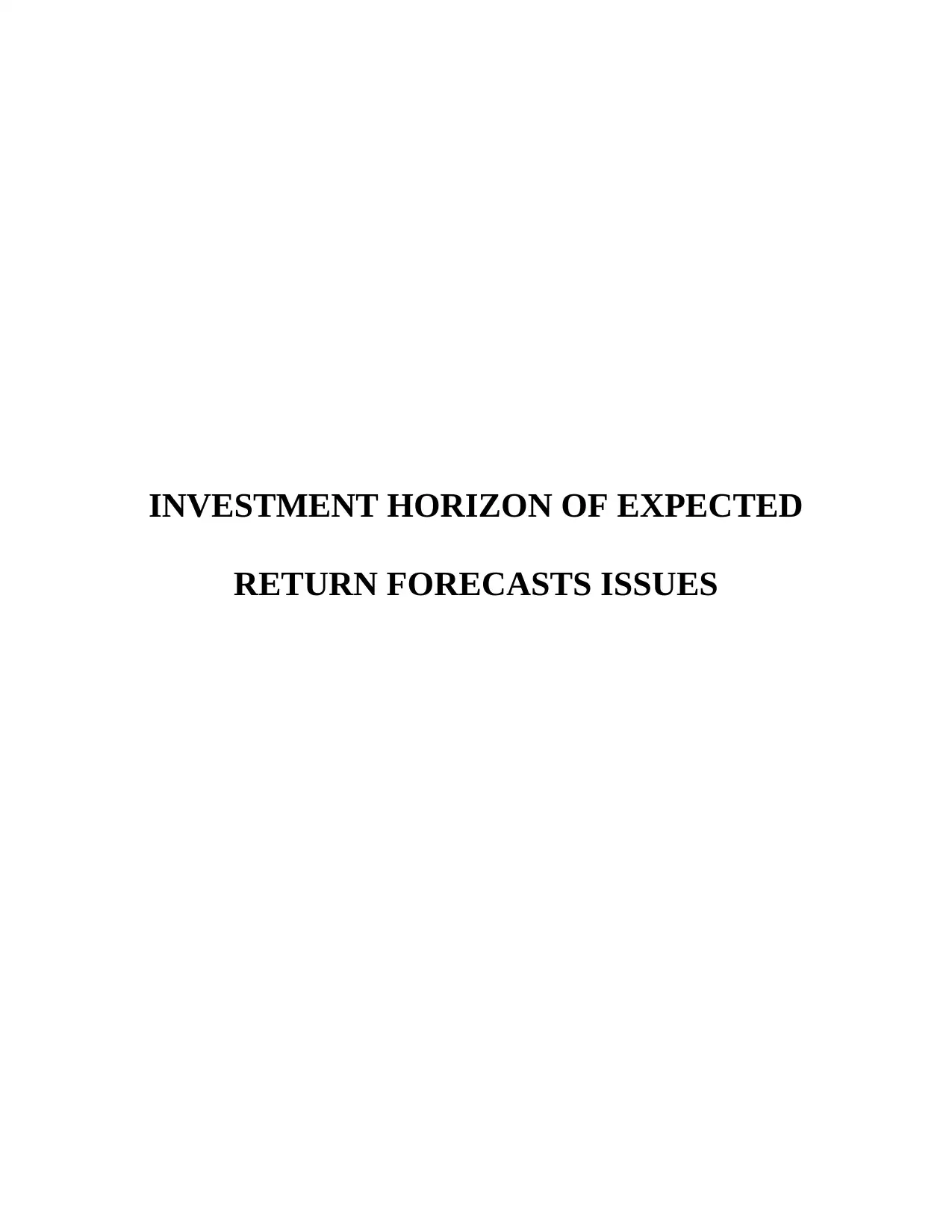
INVESTMENT HORIZON OF EXPECTED
RETURN FORECASTS ISSUES
RETURN FORECASTS ISSUES
Secure Best Marks with AI Grader
Need help grading? Try our AI Grader for instant feedback on your assignments.

ACKNOWLEDGEMENT
I am thankful to my tutor, friends and relatives who gave me guidance and support for
this project. In completing my dissertation on the suitability of equity and bond valuation
pertaining to short and long run they always encouraged me to do it in the best possible way. In
addition to this, I also appreciate my mentor for giving me guidance in preparing dissertation.
From his support and experience I was in the position to complete dissertation in a right manner.
I am thankful to my tutor, friends and relatives who gave me guidance and support for
this project. In completing my dissertation on the suitability of equity and bond valuation
pertaining to short and long run they always encouraged me to do it in the best possible way. In
addition to this, I also appreciate my mentor for giving me guidance in preparing dissertation.
From his support and experience I was in the position to complete dissertation in a right manner.
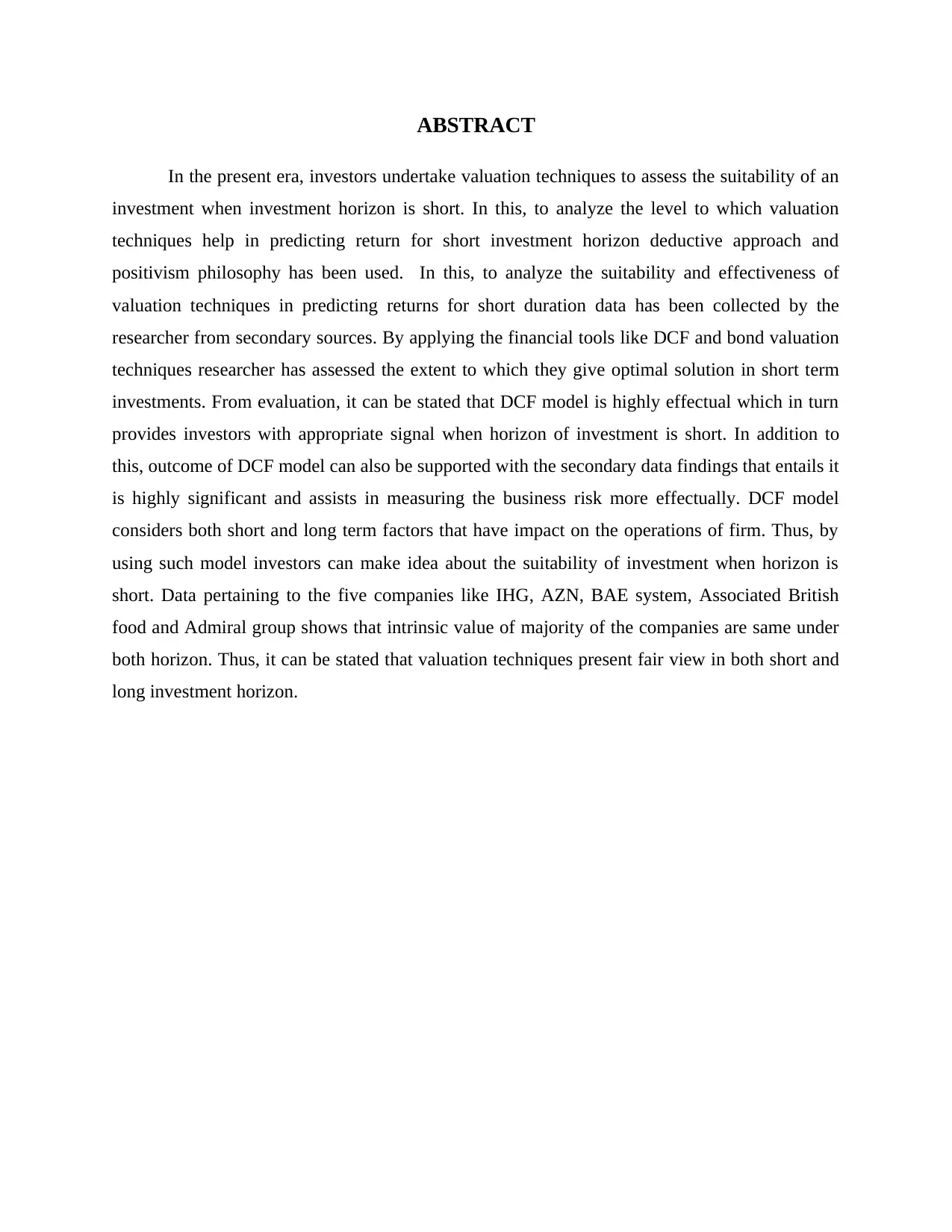
ABSTRACT
In the present era, investors undertake valuation techniques to assess the suitability of an
investment when investment horizon is short. In this, to analyze the level to which valuation
techniques help in predicting return for short investment horizon deductive approach and
positivism philosophy has been used. In this, to analyze the suitability and effectiveness of
valuation techniques in predicting returns for short duration data has been collected by the
researcher from secondary sources. By applying the financial tools like DCF and bond valuation
techniques researcher has assessed the extent to which they give optimal solution in short term
investments. From evaluation, it can be stated that DCF model is highly effectual which in turn
provides investors with appropriate signal when horizon of investment is short. In addition to
this, outcome of DCF model can also be supported with the secondary data findings that entails it
is highly significant and assists in measuring the business risk more effectually. DCF model
considers both short and long term factors that have impact on the operations of firm. Thus, by
using such model investors can make idea about the suitability of investment when horizon is
short. Data pertaining to the five companies like IHG, AZN, BAE system, Associated British
food and Admiral group shows that intrinsic value of majority of the companies are same under
both horizon. Thus, it can be stated that valuation techniques present fair view in both short and
long investment horizon.
In the present era, investors undertake valuation techniques to assess the suitability of an
investment when investment horizon is short. In this, to analyze the level to which valuation
techniques help in predicting return for short investment horizon deductive approach and
positivism philosophy has been used. In this, to analyze the suitability and effectiveness of
valuation techniques in predicting returns for short duration data has been collected by the
researcher from secondary sources. By applying the financial tools like DCF and bond valuation
techniques researcher has assessed the extent to which they give optimal solution in short term
investments. From evaluation, it can be stated that DCF model is highly effectual which in turn
provides investors with appropriate signal when horizon of investment is short. In addition to
this, outcome of DCF model can also be supported with the secondary data findings that entails it
is highly significant and assists in measuring the business risk more effectually. DCF model
considers both short and long term factors that have impact on the operations of firm. Thus, by
using such model investors can make idea about the suitability of investment when horizon is
short. Data pertaining to the five companies like IHG, AZN, BAE system, Associated British
food and Admiral group shows that intrinsic value of majority of the companies are same under
both horizon. Thus, it can be stated that valuation techniques present fair view in both short and
long investment horizon.
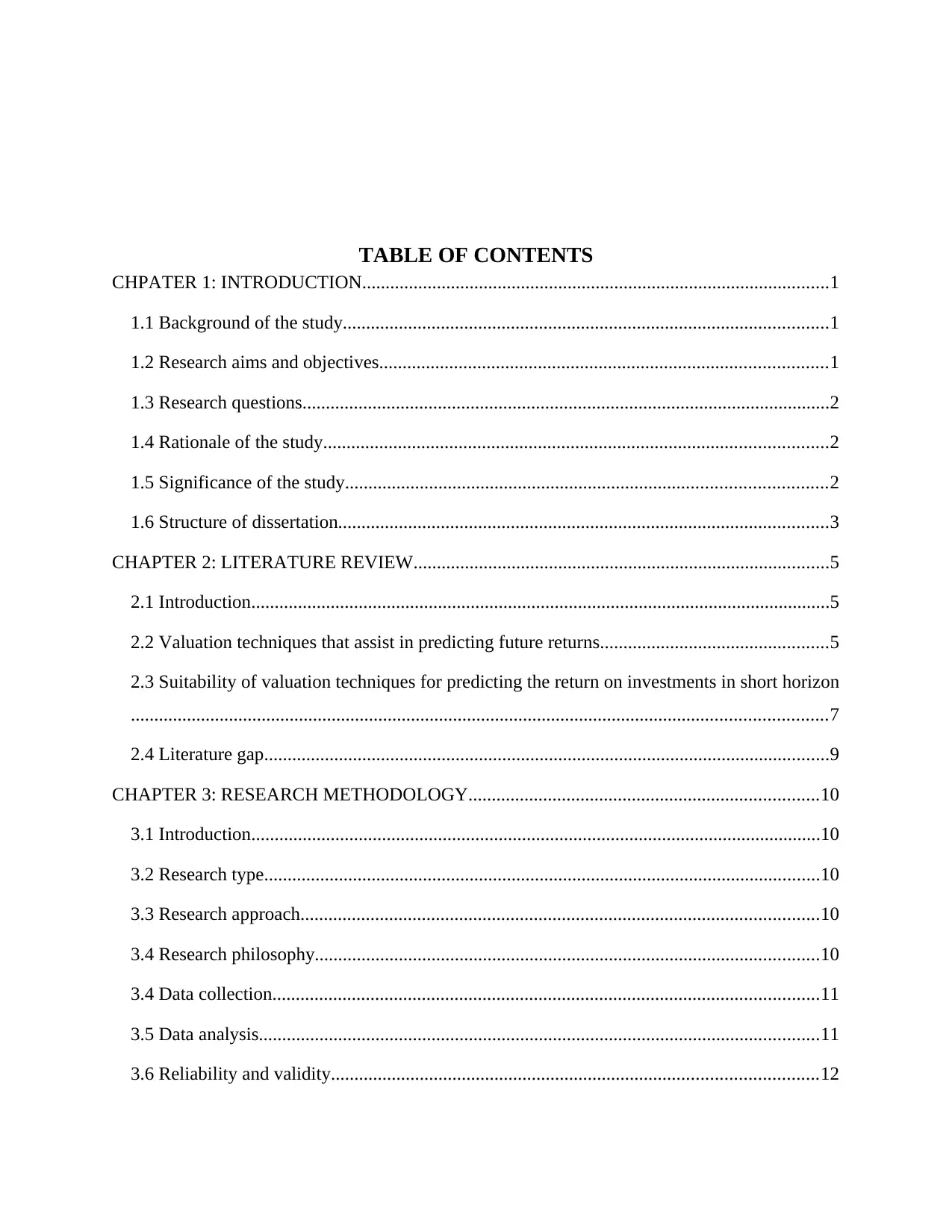
TABLE OF CONTENTS
CHPATER 1: INTRODUCTION....................................................................................................1
1.1 Background of the study........................................................................................................1
1.2 Research aims and objectives................................................................................................1
1.3 Research questions.................................................................................................................2
1.4 Rationale of the study............................................................................................................2
1.5 Significance of the study.......................................................................................................2
1.6 Structure of dissertation.........................................................................................................3
CHAPTER 2: LITERATURE REVIEW.........................................................................................5
2.1 Introduction............................................................................................................................5
2.2 Valuation techniques that assist in predicting future returns.................................................5
2.3 Suitability of valuation techniques for predicting the return on investments in short horizon
.....................................................................................................................................................7
2.4 Literature gap.........................................................................................................................9
CHAPTER 3: RESEARCH METHODOLOGY...........................................................................10
3.1 Introduction..........................................................................................................................10
3.2 Research type.......................................................................................................................10
3.3 Research approach...............................................................................................................10
3.4 Research philosophy............................................................................................................10
3.4 Data collection.....................................................................................................................11
3.5 Data analysis........................................................................................................................11
3.6 Reliability and validity........................................................................................................12
CHPATER 1: INTRODUCTION....................................................................................................1
1.1 Background of the study........................................................................................................1
1.2 Research aims and objectives................................................................................................1
1.3 Research questions.................................................................................................................2
1.4 Rationale of the study............................................................................................................2
1.5 Significance of the study.......................................................................................................2
1.6 Structure of dissertation.........................................................................................................3
CHAPTER 2: LITERATURE REVIEW.........................................................................................5
2.1 Introduction............................................................................................................................5
2.2 Valuation techniques that assist in predicting future returns.................................................5
2.3 Suitability of valuation techniques for predicting the return on investments in short horizon
.....................................................................................................................................................7
2.4 Literature gap.........................................................................................................................9
CHAPTER 3: RESEARCH METHODOLOGY...........................................................................10
3.1 Introduction..........................................................................................................................10
3.2 Research type.......................................................................................................................10
3.3 Research approach...............................................................................................................10
3.4 Research philosophy............................................................................................................10
3.4 Data collection.....................................................................................................................11
3.5 Data analysis........................................................................................................................11
3.6 Reliability and validity........................................................................................................12
Secure Best Marks with AI Grader
Need help grading? Try our AI Grader for instant feedback on your assignments.
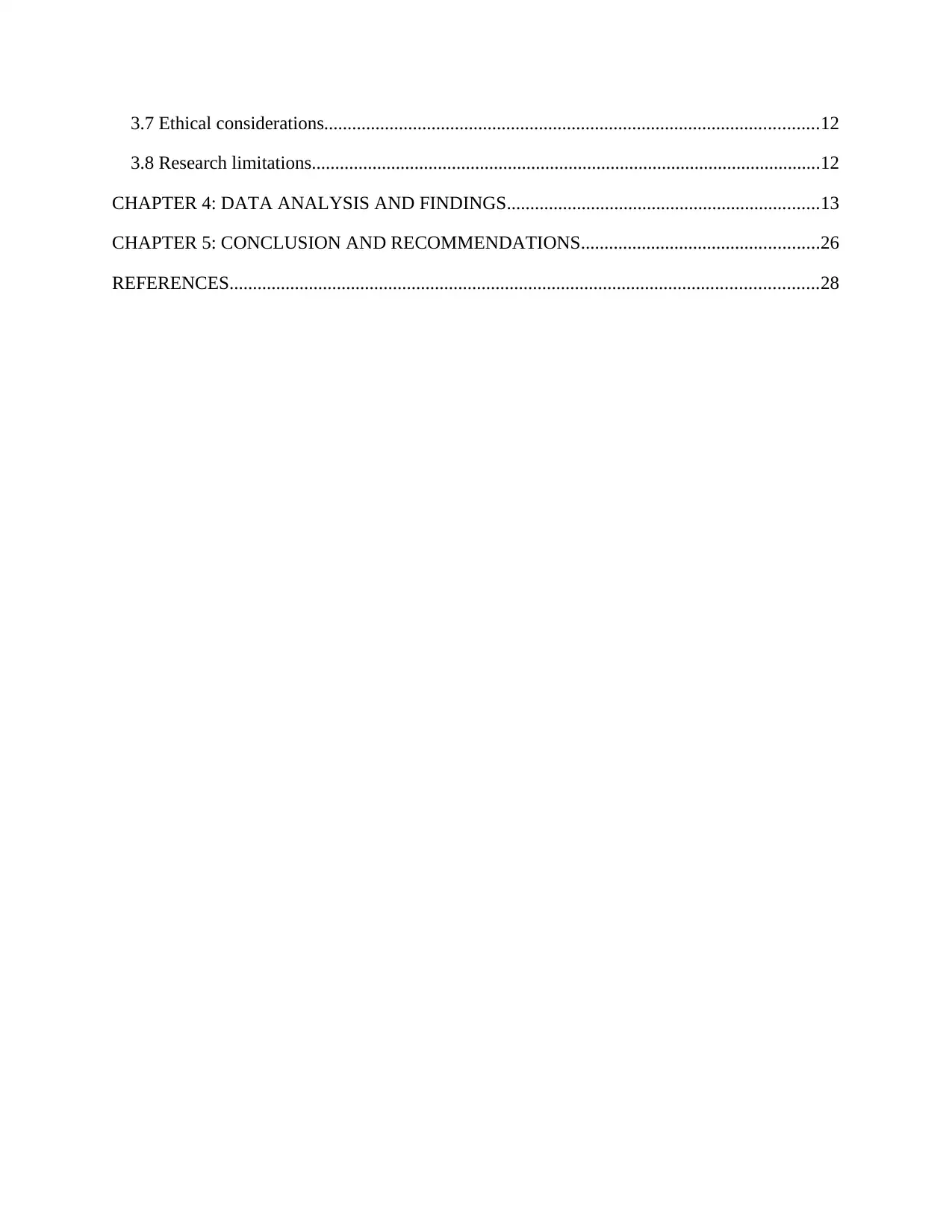
3.7 Ethical considerations..........................................................................................................12
3.8 Research limitations.............................................................................................................12
CHAPTER 4: DATA ANALYSIS AND FINDINGS...................................................................13
CHAPTER 5: CONCLUSION AND RECOMMENDATIONS...................................................26
REFERENCES..............................................................................................................................28
3.8 Research limitations.............................................................................................................12
CHAPTER 4: DATA ANALYSIS AND FINDINGS...................................................................13
CHAPTER 5: CONCLUSION AND RECOMMENDATIONS...................................................26
REFERENCES..............................................................................................................................28
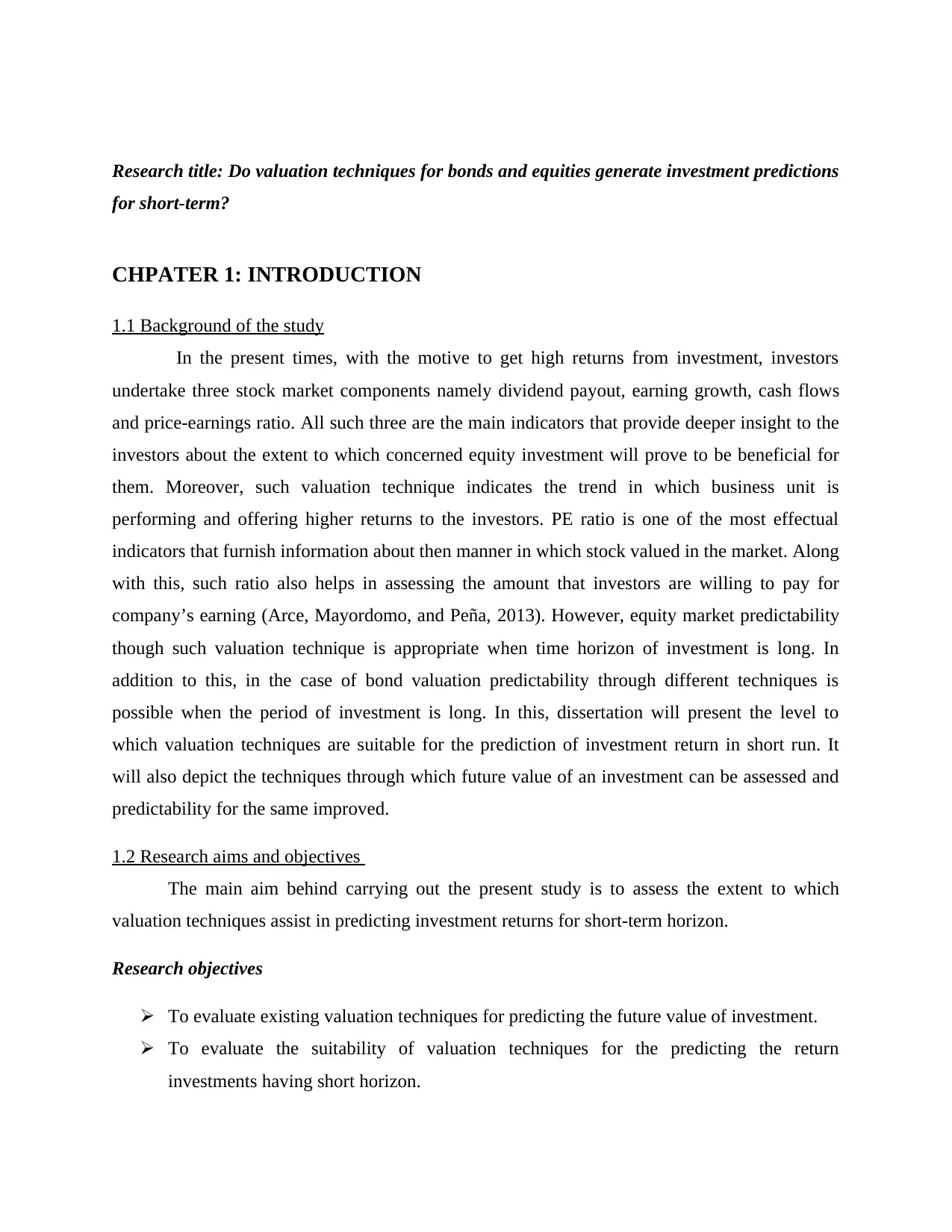
Research title: Do valuation techniques for bonds and equities generate investment predictions
for short-term?
CHPATER 1: INTRODUCTION
1.1 Background of the study
In the present times, with the motive to get high returns from investment, investors
undertake three stock market components namely dividend payout, earning growth, cash flows
and price-earnings ratio. All such three are the main indicators that provide deeper insight to the
investors about the extent to which concerned equity investment will prove to be beneficial for
them. Moreover, such valuation technique indicates the trend in which business unit is
performing and offering higher returns to the investors. PE ratio is one of the most effectual
indicators that furnish information about then manner in which stock valued in the market. Along
with this, such ratio also helps in assessing the amount that investors are willing to pay for
company’s earning (Arce, Mayordomo, and Peña, 2013). However, equity market predictability
though such valuation technique is appropriate when time horizon of investment is long. In
addition to this, in the case of bond valuation predictability through different techniques is
possible when the period of investment is long. In this, dissertation will present the level to
which valuation techniques are suitable for the prediction of investment return in short run. It
will also depict the techniques through which future value of an investment can be assessed and
predictability for the same improved.
1.2 Research aims and objectives
The main aim behind carrying out the present study is to assess the extent to which
valuation techniques assist in predicting investment returns for short-term horizon.
Research objectives
To evaluate existing valuation techniques for predicting the future value of investment.
To evaluate the suitability of valuation techniques for the predicting the return
investments having short horizon.
for short-term?
CHPATER 1: INTRODUCTION
1.1 Background of the study
In the present times, with the motive to get high returns from investment, investors
undertake three stock market components namely dividend payout, earning growth, cash flows
and price-earnings ratio. All such three are the main indicators that provide deeper insight to the
investors about the extent to which concerned equity investment will prove to be beneficial for
them. Moreover, such valuation technique indicates the trend in which business unit is
performing and offering higher returns to the investors. PE ratio is one of the most effectual
indicators that furnish information about then manner in which stock valued in the market. Along
with this, such ratio also helps in assessing the amount that investors are willing to pay for
company’s earning (Arce, Mayordomo, and Peña, 2013). However, equity market predictability
though such valuation technique is appropriate when time horizon of investment is long. In
addition to this, in the case of bond valuation predictability through different techniques is
possible when the period of investment is long. In this, dissertation will present the level to
which valuation techniques are suitable for the prediction of investment return in short run. It
will also depict the techniques through which future value of an investment can be assessed and
predictability for the same improved.
1.2 Research aims and objectives
The main aim behind carrying out the present study is to assess the extent to which
valuation techniques assist in predicting investment returns for short-term horizon.
Research objectives
To evaluate existing valuation techniques for predicting the future value of investment.
To evaluate the suitability of valuation techniques for the predicting the return
investments having short horizon.
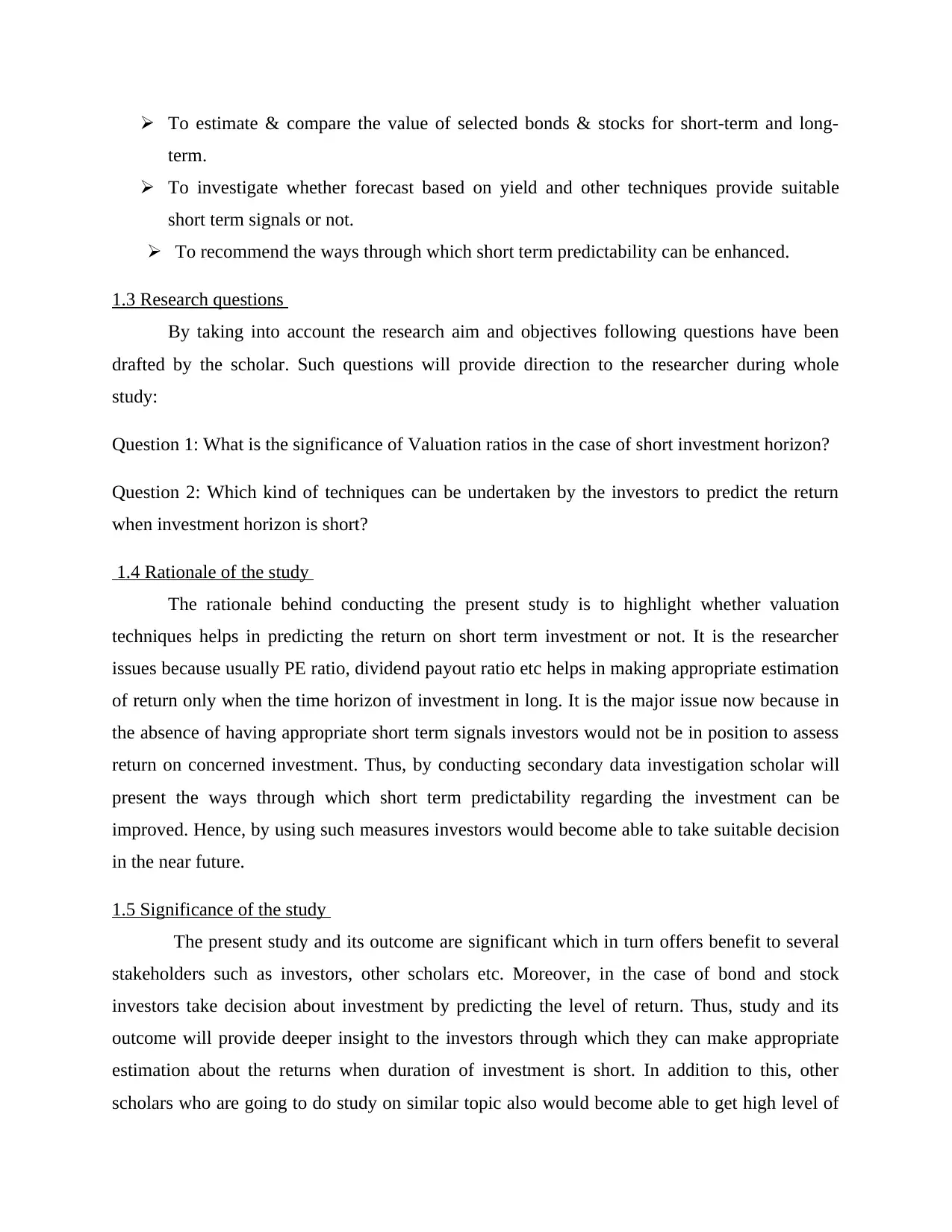
To estimate & compare the value of selected bonds & stocks for short-term and long-
term.
To investigate whether forecast based on yield and other techniques provide suitable
short term signals or not.
To recommend the ways through which short term predictability can be enhanced.
1.3 Research questions
By taking into account the research aim and objectives following questions have been
drafted by the scholar. Such questions will provide direction to the researcher during whole
study:
Question 1: What is the significance of Valuation ratios in the case of short investment horizon?
Question 2: Which kind of techniques can be undertaken by the investors to predict the return
when investment horizon is short?
1.4 Rationale of the study
The rationale behind conducting the present study is to highlight whether valuation
techniques helps in predicting the return on short term investment or not. It is the researcher
issues because usually PE ratio, dividend payout ratio etc helps in making appropriate estimation
of return only when the time horizon of investment in long. It is the major issue now because in
the absence of having appropriate short term signals investors would not be in position to assess
return on concerned investment. Thus, by conducting secondary data investigation scholar will
present the ways through which short term predictability regarding the investment can be
improved. Hence, by using such measures investors would become able to take suitable decision
in the near future.
1.5 Significance of the study
The present study and its outcome are significant which in turn offers benefit to several
stakeholders such as investors, other scholars etc. Moreover, in the case of bond and stock
investors take decision about investment by predicting the level of return. Thus, study and its
outcome will provide deeper insight to the investors through which they can make appropriate
estimation about the returns when duration of investment is short. In addition to this, other
scholars who are going to do study on similar topic also would become able to get high level of
term.
To investigate whether forecast based on yield and other techniques provide suitable
short term signals or not.
To recommend the ways through which short term predictability can be enhanced.
1.3 Research questions
By taking into account the research aim and objectives following questions have been
drafted by the scholar. Such questions will provide direction to the researcher during whole
study:
Question 1: What is the significance of Valuation ratios in the case of short investment horizon?
Question 2: Which kind of techniques can be undertaken by the investors to predict the return
when investment horizon is short?
1.4 Rationale of the study
The rationale behind conducting the present study is to highlight whether valuation
techniques helps in predicting the return on short term investment or not. It is the researcher
issues because usually PE ratio, dividend payout ratio etc helps in making appropriate estimation
of return only when the time horizon of investment in long. It is the major issue now because in
the absence of having appropriate short term signals investors would not be in position to assess
return on concerned investment. Thus, by conducting secondary data investigation scholar will
present the ways through which short term predictability regarding the investment can be
improved. Hence, by using such measures investors would become able to take suitable decision
in the near future.
1.5 Significance of the study
The present study and its outcome are significant which in turn offers benefit to several
stakeholders such as investors, other scholars etc. Moreover, in the case of bond and stock
investors take decision about investment by predicting the level of return. Thus, study and its
outcome will provide deeper insight to the investors through which they can make appropriate
estimation about the returns when duration of investment is short. In addition to this, other
scholars who are going to do study on similar topic also would become able to get high level of
Paraphrase This Document
Need a fresh take? Get an instant paraphrase of this document with our AI Paraphraser
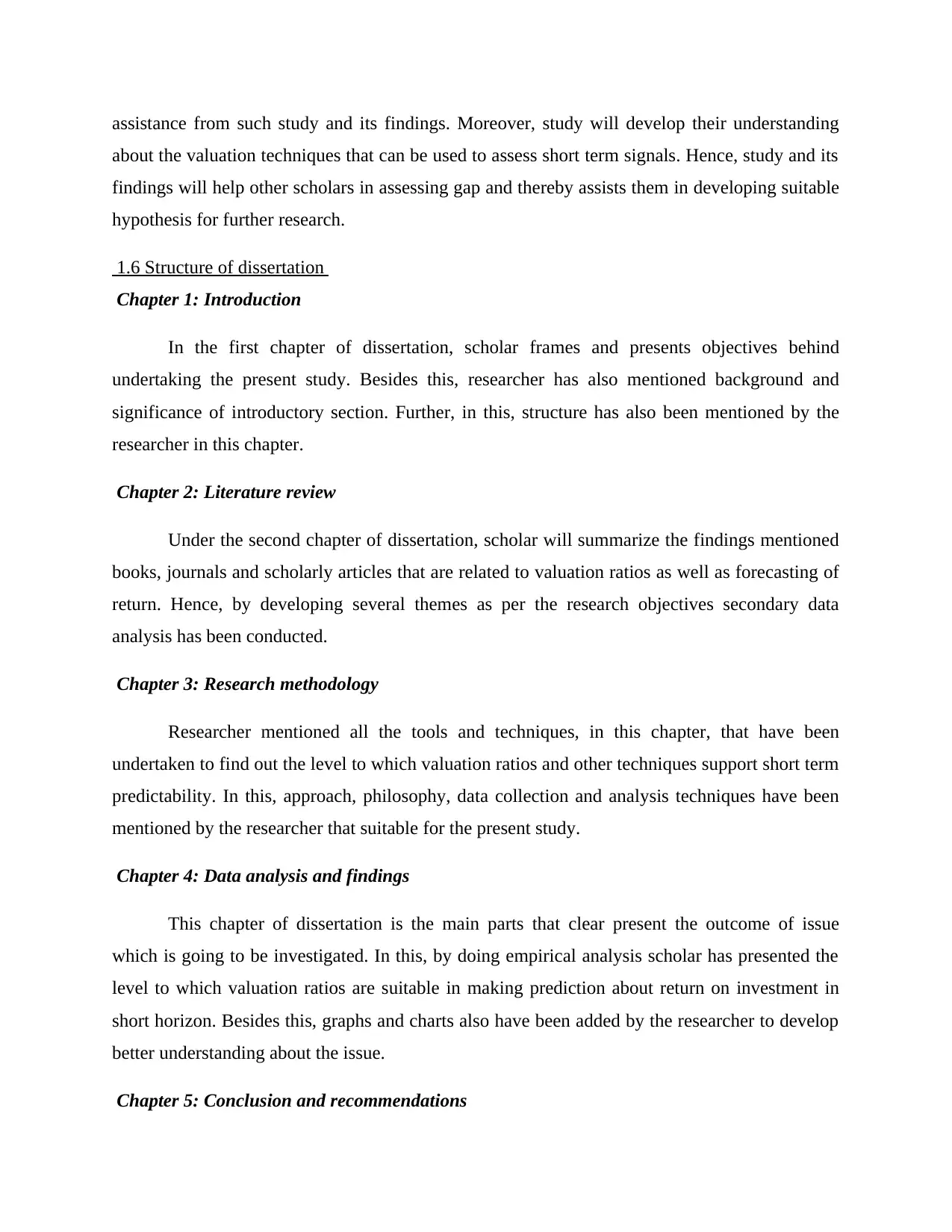
assistance from such study and its findings. Moreover, study will develop their understanding
about the valuation techniques that can be used to assess short term signals. Hence, study and its
findings will help other scholars in assessing gap and thereby assists them in developing suitable
hypothesis for further research.
1.6 Structure of dissertation
Chapter 1: Introduction
In the first chapter of dissertation, scholar frames and presents objectives behind
undertaking the present study. Besides this, researcher has also mentioned background and
significance of introductory section. Further, in this, structure has also been mentioned by the
researcher in this chapter.
Chapter 2: Literature review
Under the second chapter of dissertation, scholar will summarize the findings mentioned
books, journals and scholarly articles that are related to valuation ratios as well as forecasting of
return. Hence, by developing several themes as per the research objectives secondary data
analysis has been conducted.
Chapter 3: Research methodology
Researcher mentioned all the tools and techniques, in this chapter, that have been
undertaken to find out the level to which valuation ratios and other techniques support short term
predictability. In this, approach, philosophy, data collection and analysis techniques have been
mentioned by the researcher that suitable for the present study.
Chapter 4: Data analysis and findings
This chapter of dissertation is the main parts that clear present the outcome of issue
which is going to be investigated. In this, by doing empirical analysis scholar has presented the
level to which valuation ratios are suitable in making prediction about return on investment in
short horizon. Besides this, graphs and charts also have been added by the researcher to develop
better understanding about the issue.
Chapter 5: Conclusion and recommendations
about the valuation techniques that can be used to assess short term signals. Hence, study and its
findings will help other scholars in assessing gap and thereby assists them in developing suitable
hypothesis for further research.
1.6 Structure of dissertation
Chapter 1: Introduction
In the first chapter of dissertation, scholar frames and presents objectives behind
undertaking the present study. Besides this, researcher has also mentioned background and
significance of introductory section. Further, in this, structure has also been mentioned by the
researcher in this chapter.
Chapter 2: Literature review
Under the second chapter of dissertation, scholar will summarize the findings mentioned
books, journals and scholarly articles that are related to valuation ratios as well as forecasting of
return. Hence, by developing several themes as per the research objectives secondary data
analysis has been conducted.
Chapter 3: Research methodology
Researcher mentioned all the tools and techniques, in this chapter, that have been
undertaken to find out the level to which valuation ratios and other techniques support short term
predictability. In this, approach, philosophy, data collection and analysis techniques have been
mentioned by the researcher that suitable for the present study.
Chapter 4: Data analysis and findings
This chapter of dissertation is the main parts that clear present the outcome of issue
which is going to be investigated. In this, by doing empirical analysis scholar has presented the
level to which valuation ratios are suitable in making prediction about return on investment in
short horizon. Besides this, graphs and charts also have been added by the researcher to develop
better understanding about the issue.
Chapter 5: Conclusion and recommendations

In the final chapter of dissertation, scholar concluded the findings that are assessed
through the means of investigation about the suitability of valuation techniques for short term
investment. In addition to this, recommendations have also been provided about the aspects
through investors can make appropriate prediction about future returns.
through the means of investigation about the suitability of valuation techniques for short term
investment. In addition to this, recommendations have also been provided about the aspects
through investors can make appropriate prediction about future returns.
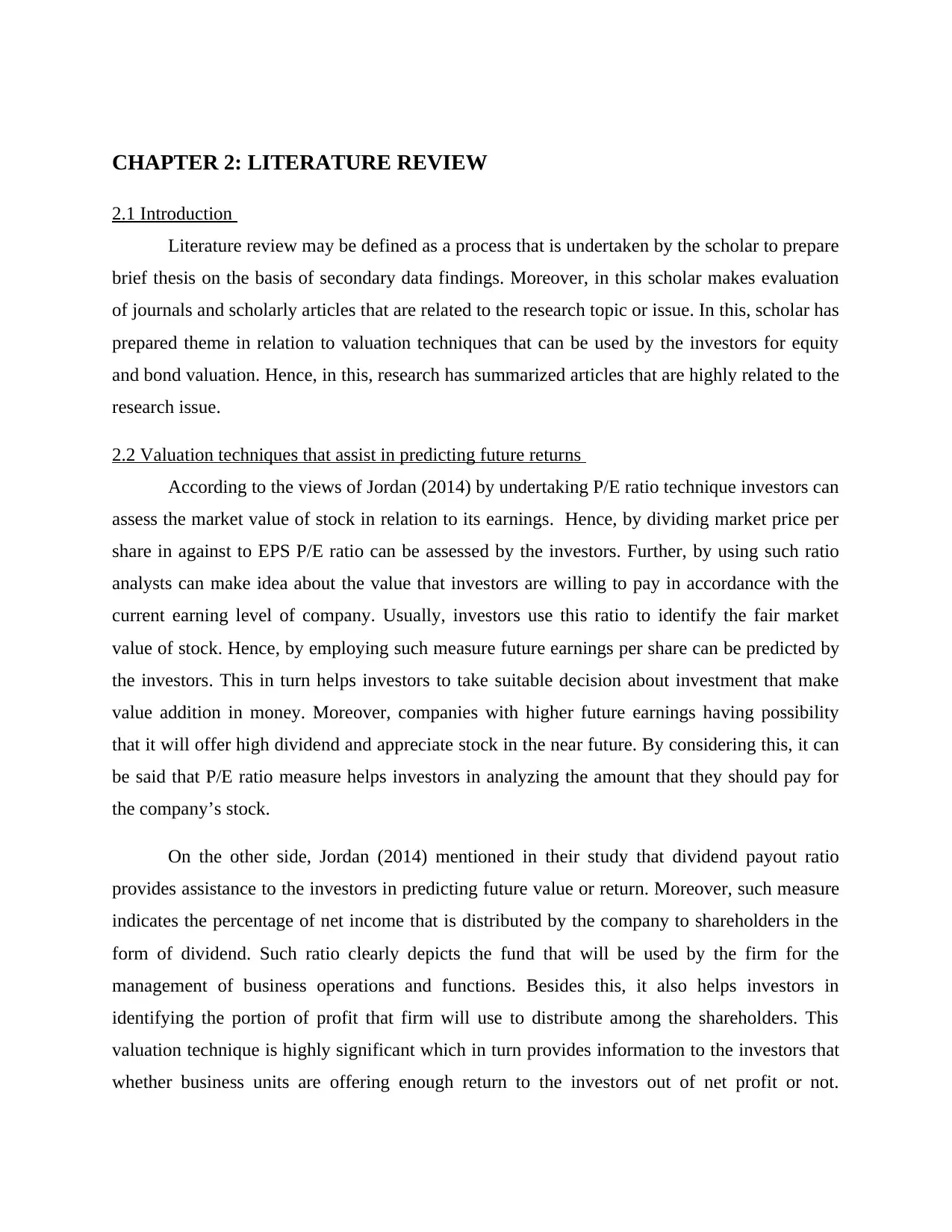
CHAPTER 2: LITERATURE REVIEW
2.1 Introduction
Literature review may be defined as a process that is undertaken by the scholar to prepare
brief thesis on the basis of secondary data findings. Moreover, in this scholar makes evaluation
of journals and scholarly articles that are related to the research topic or issue. In this, scholar has
prepared theme in relation to valuation techniques that can be used by the investors for equity
and bond valuation. Hence, in this, research has summarized articles that are highly related to the
research issue.
2.2 Valuation techniques that assist in predicting future returns
According to the views of Jordan (2014) by undertaking P/E ratio technique investors can
assess the market value of stock in relation to its earnings. Hence, by dividing market price per
share in against to EPS P/E ratio can be assessed by the investors. Further, by using such ratio
analysts can make idea about the value that investors are willing to pay in accordance with the
current earning level of company. Usually, investors use this ratio to identify the fair market
value of stock. Hence, by employing such measure future earnings per share can be predicted by
the investors. This in turn helps investors to take suitable decision about investment that make
value addition in money. Moreover, companies with higher future earnings having possibility
that it will offer high dividend and appreciate stock in the near future. By considering this, it can
be said that P/E ratio measure helps investors in analyzing the amount that they should pay for
the company’s stock.
On the other side, Jordan (2014) mentioned in their study that dividend payout ratio
provides assistance to the investors in predicting future value or return. Moreover, such measure
indicates the percentage of net income that is distributed by the company to shareholders in the
form of dividend. Such ratio clearly depicts the fund that will be used by the firm for the
management of business operations and functions. Besides this, it also helps investors in
identifying the portion of profit that firm will use to distribute among the shareholders. This
valuation technique is highly significant which in turn provides information to the investors that
whether business units are offering enough return to the investors out of net profit or not.
2.1 Introduction
Literature review may be defined as a process that is undertaken by the scholar to prepare
brief thesis on the basis of secondary data findings. Moreover, in this scholar makes evaluation
of journals and scholarly articles that are related to the research topic or issue. In this, scholar has
prepared theme in relation to valuation techniques that can be used by the investors for equity
and bond valuation. Hence, in this, research has summarized articles that are highly related to the
research issue.
2.2 Valuation techniques that assist in predicting future returns
According to the views of Jordan (2014) by undertaking P/E ratio technique investors can
assess the market value of stock in relation to its earnings. Hence, by dividing market price per
share in against to EPS P/E ratio can be assessed by the investors. Further, by using such ratio
analysts can make idea about the value that investors are willing to pay in accordance with the
current earning level of company. Usually, investors use this ratio to identify the fair market
value of stock. Hence, by employing such measure future earnings per share can be predicted by
the investors. This in turn helps investors to take suitable decision about investment that make
value addition in money. Moreover, companies with higher future earnings having possibility
that it will offer high dividend and appreciate stock in the near future. By considering this, it can
be said that P/E ratio measure helps investors in analyzing the amount that they should pay for
the company’s stock.
On the other side, Jordan (2014) mentioned in their study that dividend payout ratio
provides assistance to the investors in predicting future value or return. Moreover, such measure
indicates the percentage of net income that is distributed by the company to shareholders in the
form of dividend. Such ratio clearly depicts the fund that will be used by the firm for the
management of business operations and functions. Besides this, it also helps investors in
identifying the portion of profit that firm will use to distribute among the shareholders. This
valuation technique is highly significant which in turn provides information to the investors that
whether business units are offering enough return to the investors out of net profit or not.
Secure Best Marks with AI Grader
Need help grading? Try our AI Grader for instant feedback on your assignments.
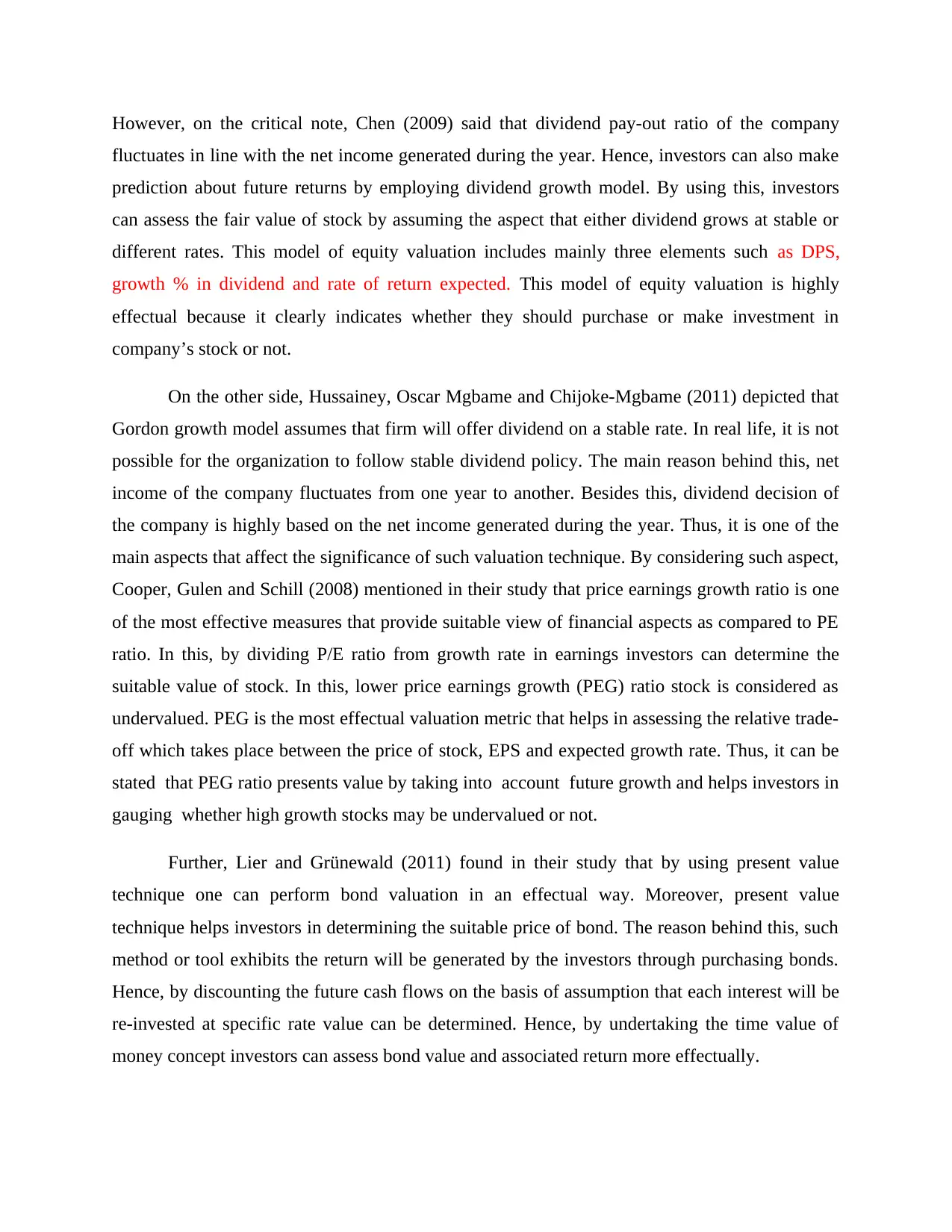
However, on the critical note, Chen (2009) said that dividend pay-out ratio of the company
fluctuates in line with the net income generated during the year. Hence, investors can also make
prediction about future returns by employing dividend growth model. By using this, investors
can assess the fair value of stock by assuming the aspect that either dividend grows at stable or
different rates. This model of equity valuation includes mainly three elements such as DPS,
growth % in dividend and rate of return expected. This model of equity valuation is highly
effectual because it clearly indicates whether they should purchase or make investment in
company’s stock or not.
On the other side, Hussainey, Oscar Mgbame and Chijoke-Mgbame (2011) depicted that
Gordon growth model assumes that firm will offer dividend on a stable rate. In real life, it is not
possible for the organization to follow stable dividend policy. The main reason behind this, net
income of the company fluctuates from one year to another. Besides this, dividend decision of
the company is highly based on the net income generated during the year. Thus, it is one of the
main aspects that affect the significance of such valuation technique. By considering such aspect,
Cooper, Gulen and Schill (2008) mentioned in their study that price earnings growth ratio is one
of the most effective measures that provide suitable view of financial aspects as compared to PE
ratio. In this, by dividing P/E ratio from growth rate in earnings investors can determine the
suitable value of stock. In this, lower price earnings growth (PEG) ratio stock is considered as
undervalued. PEG is the most effectual valuation metric that helps in assessing the relative trade-
off which takes place between the price of stock, EPS and expected growth rate. Thus, it can be
stated that PEG ratio presents value by taking into account future growth and helps investors in
gauging whether high growth stocks may be undervalued or not.
Further, Lier and Grünewald (2011) found in their study that by using present value
technique one can perform bond valuation in an effectual way. Moreover, present value
technique helps investors in determining the suitable price of bond. The reason behind this, such
method or tool exhibits the return will be generated by the investors through purchasing bonds.
Hence, by discounting the future cash flows on the basis of assumption that each interest will be
re-invested at specific rate value can be determined. Hence, by undertaking the time value of
money concept investors can assess bond value and associated return more effectually.
fluctuates in line with the net income generated during the year. Hence, investors can also make
prediction about future returns by employing dividend growth model. By using this, investors
can assess the fair value of stock by assuming the aspect that either dividend grows at stable or
different rates. This model of equity valuation includes mainly three elements such as DPS,
growth % in dividend and rate of return expected. This model of equity valuation is highly
effectual because it clearly indicates whether they should purchase or make investment in
company’s stock or not.
On the other side, Hussainey, Oscar Mgbame and Chijoke-Mgbame (2011) depicted that
Gordon growth model assumes that firm will offer dividend on a stable rate. In real life, it is not
possible for the organization to follow stable dividend policy. The main reason behind this, net
income of the company fluctuates from one year to another. Besides this, dividend decision of
the company is highly based on the net income generated during the year. Thus, it is one of the
main aspects that affect the significance of such valuation technique. By considering such aspect,
Cooper, Gulen and Schill (2008) mentioned in their study that price earnings growth ratio is one
of the most effective measures that provide suitable view of financial aspects as compared to PE
ratio. In this, by dividing P/E ratio from growth rate in earnings investors can determine the
suitable value of stock. In this, lower price earnings growth (PEG) ratio stock is considered as
undervalued. PEG is the most effectual valuation metric that helps in assessing the relative trade-
off which takes place between the price of stock, EPS and expected growth rate. Thus, it can be
stated that PEG ratio presents value by taking into account future growth and helps investors in
gauging whether high growth stocks may be undervalued or not.
Further, Lier and Grünewald (2011) found in their study that by using present value
technique one can perform bond valuation in an effectual way. Moreover, present value
technique helps investors in determining the suitable price of bond. The reason behind this, such
method or tool exhibits the return will be generated by the investors through purchasing bonds.
Hence, by discounting the future cash flows on the basis of assumption that each interest will be
re-invested at specific rate value can be determined. Hence, by undertaking the time value of
money concept investors can assess bond value and associated return more effectually.
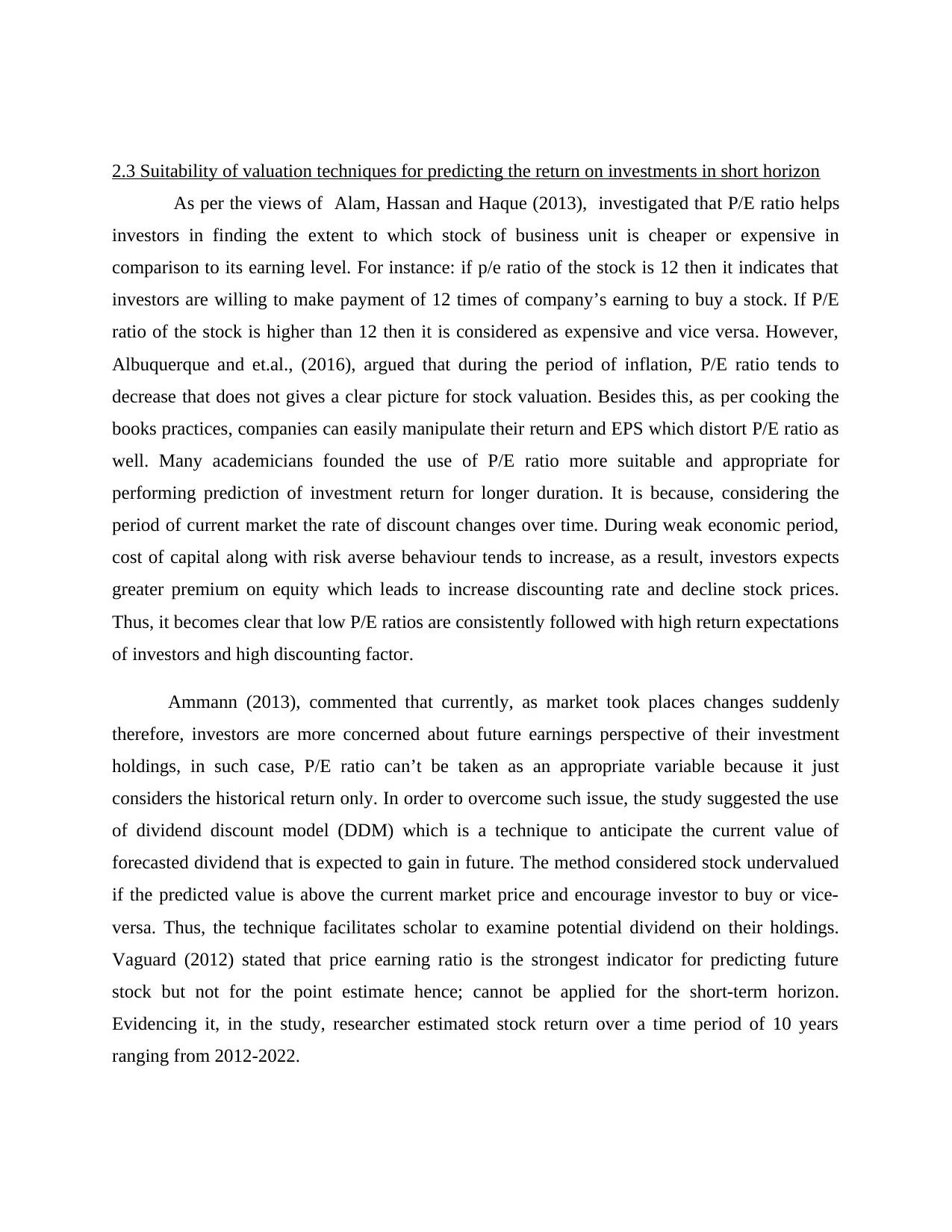
2.3 Suitability of valuation techniques for predicting the return on investments in short horizon
As per the views of Alam, Hassan and Haque (2013), investigated that P/E ratio helps
investors in finding the extent to which stock of business unit is cheaper or expensive in
comparison to its earning level. For instance: if p/e ratio of the stock is 12 then it indicates that
investors are willing to make payment of 12 times of company’s earning to buy a stock. If P/E
ratio of the stock is higher than 12 then it is considered as expensive and vice versa. However,
Albuquerque and et.al., (2016), argued that during the period of inflation, P/E ratio tends to
decrease that does not gives a clear picture for stock valuation. Besides this, as per cooking the
books practices, companies can easily manipulate their return and EPS which distort P/E ratio as
well. Many academicians founded the use of P/E ratio more suitable and appropriate for
performing prediction of investment return for longer duration. It is because, considering the
period of current market the rate of discount changes over time. During weak economic period,
cost of capital along with risk averse behaviour tends to increase, as a result, investors expects
greater premium on equity which leads to increase discounting rate and decline stock prices.
Thus, it becomes clear that low P/E ratios are consistently followed with high return expectations
of investors and high discounting factor.
Ammann (2013), commented that currently, as market took places changes suddenly
therefore, investors are more concerned about future earnings perspective of their investment
holdings, in such case, P/E ratio can’t be taken as an appropriate variable because it just
considers the historical return only. In order to overcome such issue, the study suggested the use
of dividend discount model (DDM) which is a technique to anticipate the current value of
forecasted dividend that is expected to gain in future. The method considered stock undervalued
if the predicted value is above the current market price and encourage investor to buy or vice-
versa. Thus, the technique facilitates scholar to examine potential dividend on their holdings.
Vaguard (2012) stated that price earning ratio is the strongest indicator for predicting future
stock but not for the point estimate hence; cannot be applied for the short-term horizon.
Evidencing it, in the study, researcher estimated stock return over a time period of 10 years
ranging from 2012-2022.
As per the views of Alam, Hassan and Haque (2013), investigated that P/E ratio helps
investors in finding the extent to which stock of business unit is cheaper or expensive in
comparison to its earning level. For instance: if p/e ratio of the stock is 12 then it indicates that
investors are willing to make payment of 12 times of company’s earning to buy a stock. If P/E
ratio of the stock is higher than 12 then it is considered as expensive and vice versa. However,
Albuquerque and et.al., (2016), argued that during the period of inflation, P/E ratio tends to
decrease that does not gives a clear picture for stock valuation. Besides this, as per cooking the
books practices, companies can easily manipulate their return and EPS which distort P/E ratio as
well. Many academicians founded the use of P/E ratio more suitable and appropriate for
performing prediction of investment return for longer duration. It is because, considering the
period of current market the rate of discount changes over time. During weak economic period,
cost of capital along with risk averse behaviour tends to increase, as a result, investors expects
greater premium on equity which leads to increase discounting rate and decline stock prices.
Thus, it becomes clear that low P/E ratios are consistently followed with high return expectations
of investors and high discounting factor.
Ammann (2013), commented that currently, as market took places changes suddenly
therefore, investors are more concerned about future earnings perspective of their investment
holdings, in such case, P/E ratio can’t be taken as an appropriate variable because it just
considers the historical return only. In order to overcome such issue, the study suggested the use
of dividend discount model (DDM) which is a technique to anticipate the current value of
forecasted dividend that is expected to gain in future. The method considered stock undervalued
if the predicted value is above the current market price and encourage investor to buy or vice-
versa. Thus, the technique facilitates scholar to examine potential dividend on their holdings.
Vaguard (2012) stated that price earning ratio is the strongest indicator for predicting future
stock but not for the point estimate hence; cannot be applied for the short-term horizon.
Evidencing it, in the study, researcher estimated stock return over a time period of 10 years
ranging from 2012-2022.
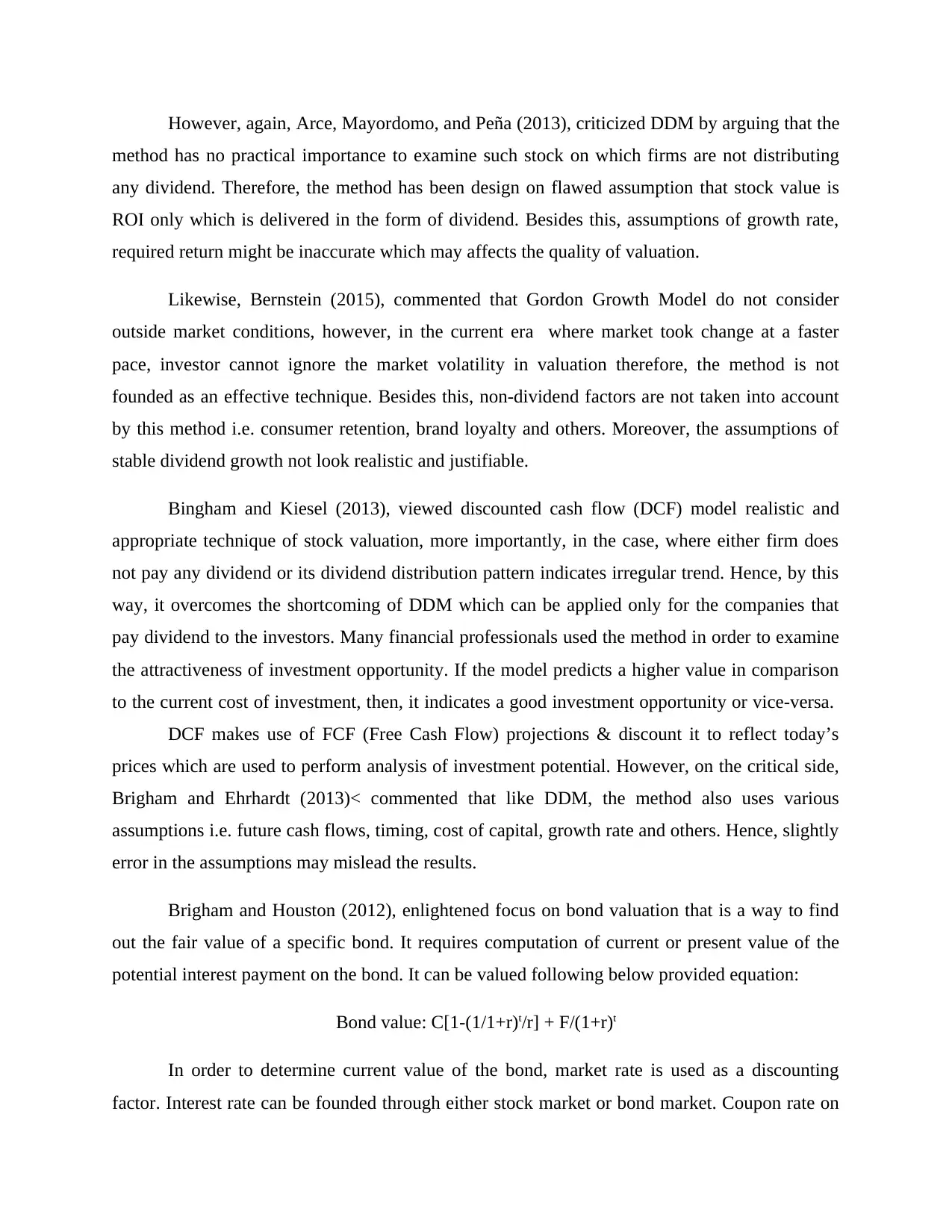
However, again, Arce, Mayordomo, and Peña (2013), criticized DDM by arguing that the
method has no practical importance to examine such stock on which firms are not distributing
any dividend. Therefore, the method has been design on flawed assumption that stock value is
ROI only which is delivered in the form of dividend. Besides this, assumptions of growth rate,
required return might be inaccurate which may affects the quality of valuation.
Likewise, Bernstein (2015), commented that Gordon Growth Model do not consider
outside market conditions, however, in the current era where market took change at a faster
pace, investor cannot ignore the market volatility in valuation therefore, the method is not
founded as an effective technique. Besides this, non-dividend factors are not taken into account
by this method i.e. consumer retention, brand loyalty and others. Moreover, the assumptions of
stable dividend growth not look realistic and justifiable.
Bingham and Kiesel (2013), viewed discounted cash flow (DCF) model realistic and
appropriate technique of stock valuation, more importantly, in the case, where either firm does
not pay any dividend or its dividend distribution pattern indicates irregular trend. Hence, by this
way, it overcomes the shortcoming of DDM which can be applied only for the companies that
pay dividend to the investors. Many financial professionals used the method in order to examine
the attractiveness of investment opportunity. If the model predicts a higher value in comparison
to the current cost of investment, then, it indicates a good investment opportunity or vice-versa.
DCF makes use of FCF (Free Cash Flow) projections & discount it to reflect today’s
prices which are used to perform analysis of investment potential. However, on the critical side,
Brigham and Ehrhardt (2013)< commented that like DDM, the method also uses various
assumptions i.e. future cash flows, timing, cost of capital, growth rate and others. Hence, slightly
error in the assumptions may mislead the results.
Brigham and Houston (2012), enlightened focus on bond valuation that is a way to find
out the fair value of a specific bond. It requires computation of current or present value of the
potential interest payment on the bond. It can be valued following below provided equation:
Bond value: C[1-(1/1+r)t/r] + F/(1+r)t
In order to determine current value of the bond, market rate is used as a discounting
factor. Interest rate can be founded through either stock market or bond market. Coupon rate on
method has no practical importance to examine such stock on which firms are not distributing
any dividend. Therefore, the method has been design on flawed assumption that stock value is
ROI only which is delivered in the form of dividend. Besides this, assumptions of growth rate,
required return might be inaccurate which may affects the quality of valuation.
Likewise, Bernstein (2015), commented that Gordon Growth Model do not consider
outside market conditions, however, in the current era where market took change at a faster
pace, investor cannot ignore the market volatility in valuation therefore, the method is not
founded as an effective technique. Besides this, non-dividend factors are not taken into account
by this method i.e. consumer retention, brand loyalty and others. Moreover, the assumptions of
stable dividend growth not look realistic and justifiable.
Bingham and Kiesel (2013), viewed discounted cash flow (DCF) model realistic and
appropriate technique of stock valuation, more importantly, in the case, where either firm does
not pay any dividend or its dividend distribution pattern indicates irregular trend. Hence, by this
way, it overcomes the shortcoming of DDM which can be applied only for the companies that
pay dividend to the investors. Many financial professionals used the method in order to examine
the attractiveness of investment opportunity. If the model predicts a higher value in comparison
to the current cost of investment, then, it indicates a good investment opportunity or vice-versa.
DCF makes use of FCF (Free Cash Flow) projections & discount it to reflect today’s
prices which are used to perform analysis of investment potential. However, on the critical side,
Brigham and Ehrhardt (2013)< commented that like DDM, the method also uses various
assumptions i.e. future cash flows, timing, cost of capital, growth rate and others. Hence, slightly
error in the assumptions may mislead the results.
Brigham and Houston (2012), enlightened focus on bond valuation that is a way to find
out the fair value of a specific bond. It requires computation of current or present value of the
potential interest payment on the bond. It can be valued following below provided equation:
Bond value: C[1-(1/1+r)t/r] + F/(1+r)t
In order to determine current value of the bond, market rate is used as a discounting
factor. Interest rate can be founded through either stock market or bond market. Coupon rate on
Paraphrase This Document
Need a fresh take? Get an instant paraphrase of this document with our AI Paraphraser
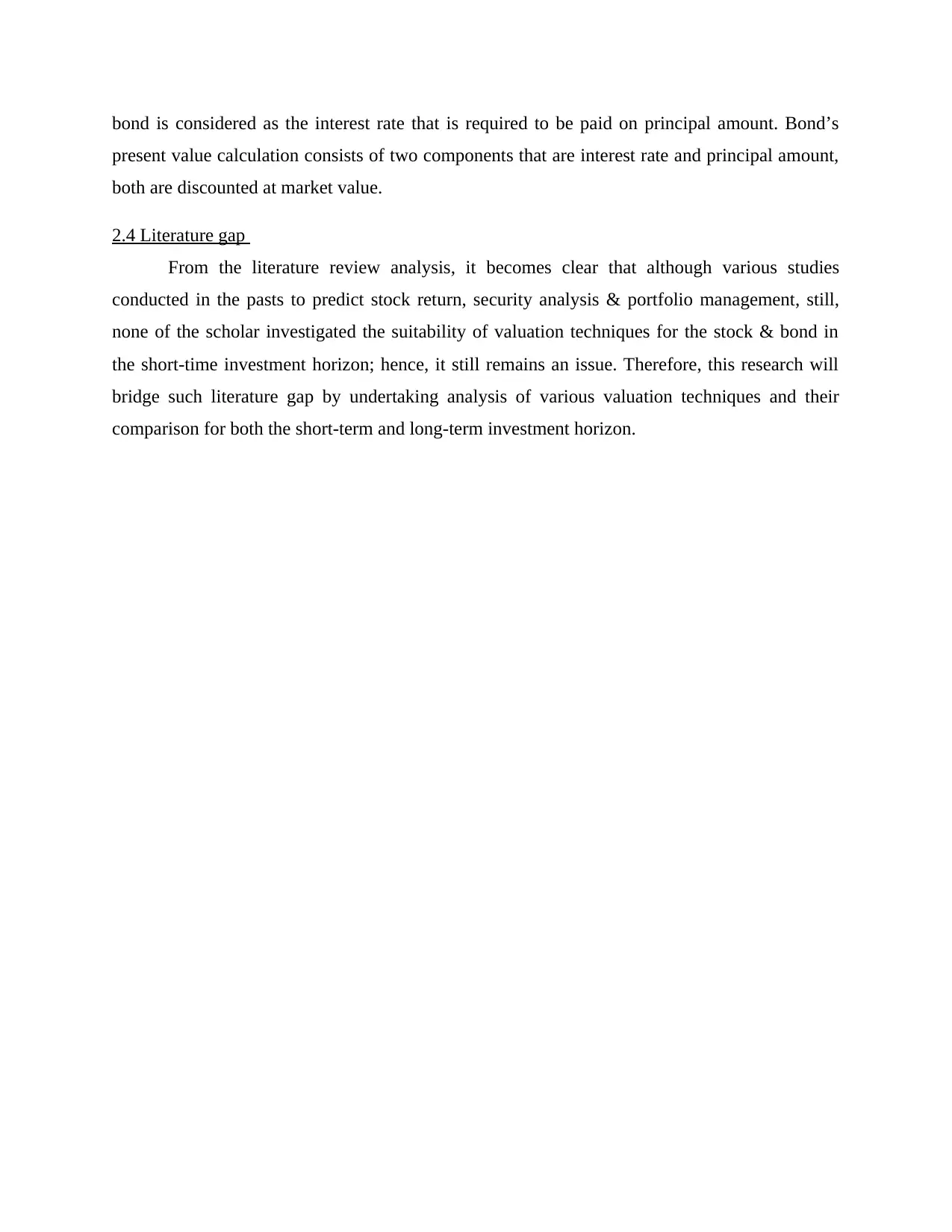
bond is considered as the interest rate that is required to be paid on principal amount. Bond’s
present value calculation consists of two components that are interest rate and principal amount,
both are discounted at market value.
2.4 Literature gap
From the literature review analysis, it becomes clear that although various studies
conducted in the pasts to predict stock return, security analysis & portfolio management, still,
none of the scholar investigated the suitability of valuation techniques for the stock & bond in
the short-time investment horizon; hence, it still remains an issue. Therefore, this research will
bridge such literature gap by undertaking analysis of various valuation techniques and their
comparison for both the short-term and long-term investment horizon.
present value calculation consists of two components that are interest rate and principal amount,
both are discounted at market value.
2.4 Literature gap
From the literature review analysis, it becomes clear that although various studies
conducted in the pasts to predict stock return, security analysis & portfolio management, still,
none of the scholar investigated the suitability of valuation techniques for the stock & bond in
the short-time investment horizon; hence, it still remains an issue. Therefore, this research will
bridge such literature gap by undertaking analysis of various valuation techniques and their
comparison for both the short-term and long-term investment horizon.
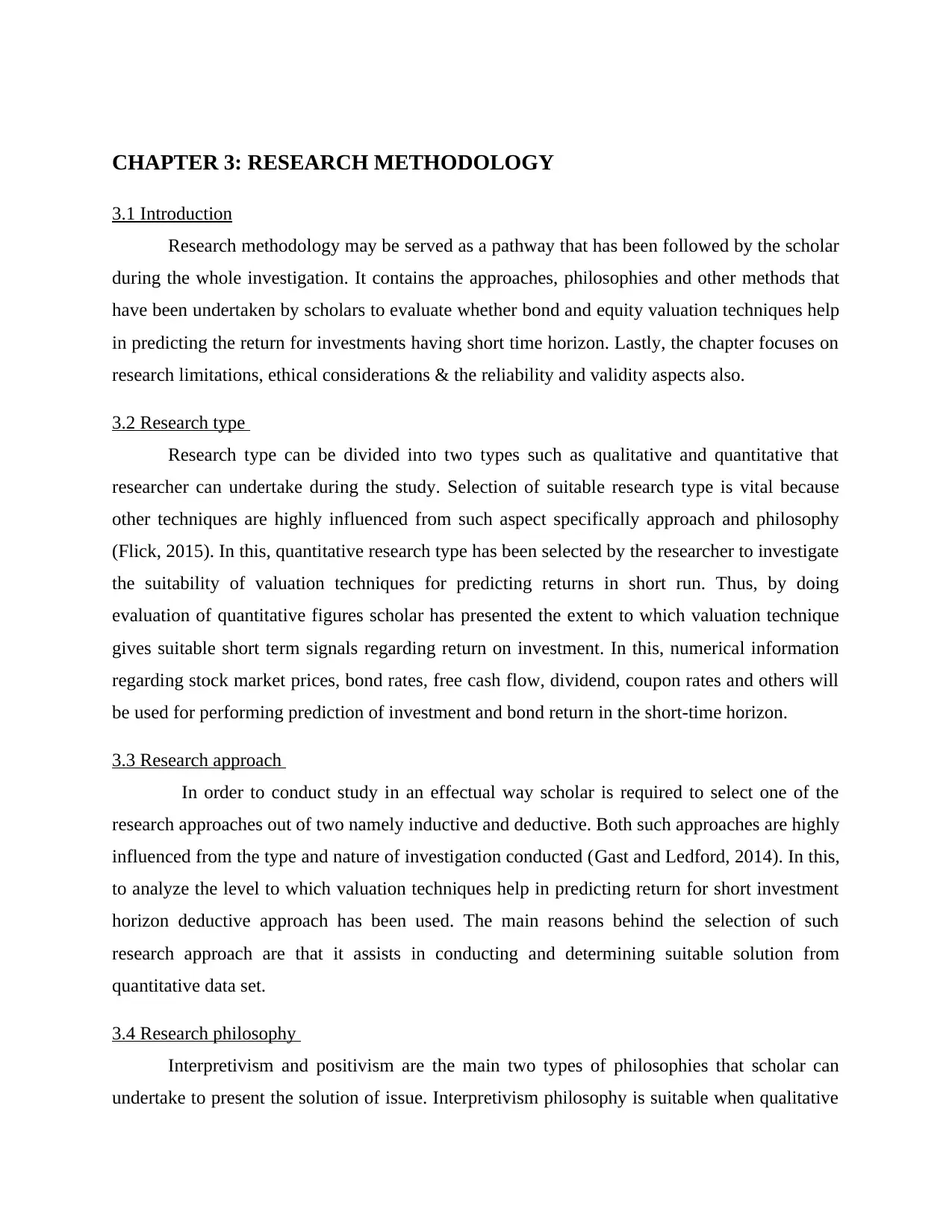
CHAPTER 3: RESEARCH METHODOLOGY
3.1 Introduction
Research methodology may be served as a pathway that has been followed by the scholar
during the whole investigation. It contains the approaches, philosophies and other methods that
have been undertaken by scholars to evaluate whether bond and equity valuation techniques help
in predicting the return for investments having short time horizon. Lastly, the chapter focuses on
research limitations, ethical considerations & the reliability and validity aspects also.
3.2 Research type
Research type can be divided into two types such as qualitative and quantitative that
researcher can undertake during the study. Selection of suitable research type is vital because
other techniques are highly influenced from such aspect specifically approach and philosophy
(Flick, 2015). In this, quantitative research type has been selected by the researcher to investigate
the suitability of valuation techniques for predicting returns in short run. Thus, by doing
evaluation of quantitative figures scholar has presented the extent to which valuation technique
gives suitable short term signals regarding return on investment. In this, numerical information
regarding stock market prices, bond rates, free cash flow, dividend, coupon rates and others will
be used for performing prediction of investment and bond return in the short-time horizon.
3.3 Research approach
In order to conduct study in an effectual way scholar is required to select one of the
research approaches out of two namely inductive and deductive. Both such approaches are highly
influenced from the type and nature of investigation conducted (Gast and Ledford, 2014). In this,
to analyze the level to which valuation techniques help in predicting return for short investment
horizon deductive approach has been used. The main reasons behind the selection of such
research approach are that it assists in conducting and determining suitable solution from
quantitative data set.
3.4 Research philosophy
Interpretivism and positivism are the main two types of philosophies that scholar can
undertake to present the solution of issue. Interpretivism philosophy is suitable when qualitative
3.1 Introduction
Research methodology may be served as a pathway that has been followed by the scholar
during the whole investigation. It contains the approaches, philosophies and other methods that
have been undertaken by scholars to evaluate whether bond and equity valuation techniques help
in predicting the return for investments having short time horizon. Lastly, the chapter focuses on
research limitations, ethical considerations & the reliability and validity aspects also.
3.2 Research type
Research type can be divided into two types such as qualitative and quantitative that
researcher can undertake during the study. Selection of suitable research type is vital because
other techniques are highly influenced from such aspect specifically approach and philosophy
(Flick, 2015). In this, quantitative research type has been selected by the researcher to investigate
the suitability of valuation techniques for predicting returns in short run. Thus, by doing
evaluation of quantitative figures scholar has presented the extent to which valuation technique
gives suitable short term signals regarding return on investment. In this, numerical information
regarding stock market prices, bond rates, free cash flow, dividend, coupon rates and others will
be used for performing prediction of investment and bond return in the short-time horizon.
3.3 Research approach
In order to conduct study in an effectual way scholar is required to select one of the
research approaches out of two namely inductive and deductive. Both such approaches are highly
influenced from the type and nature of investigation conducted (Gast and Ledford, 2014). In this,
to analyze the level to which valuation techniques help in predicting return for short investment
horizon deductive approach has been used. The main reasons behind the selection of such
research approach are that it assists in conducting and determining suitable solution from
quantitative data set.
3.4 Research philosophy
Interpretivism and positivism are the main two types of philosophies that scholar can
undertake to present the solution of issue. Interpretivism philosophy is suitable when qualitative
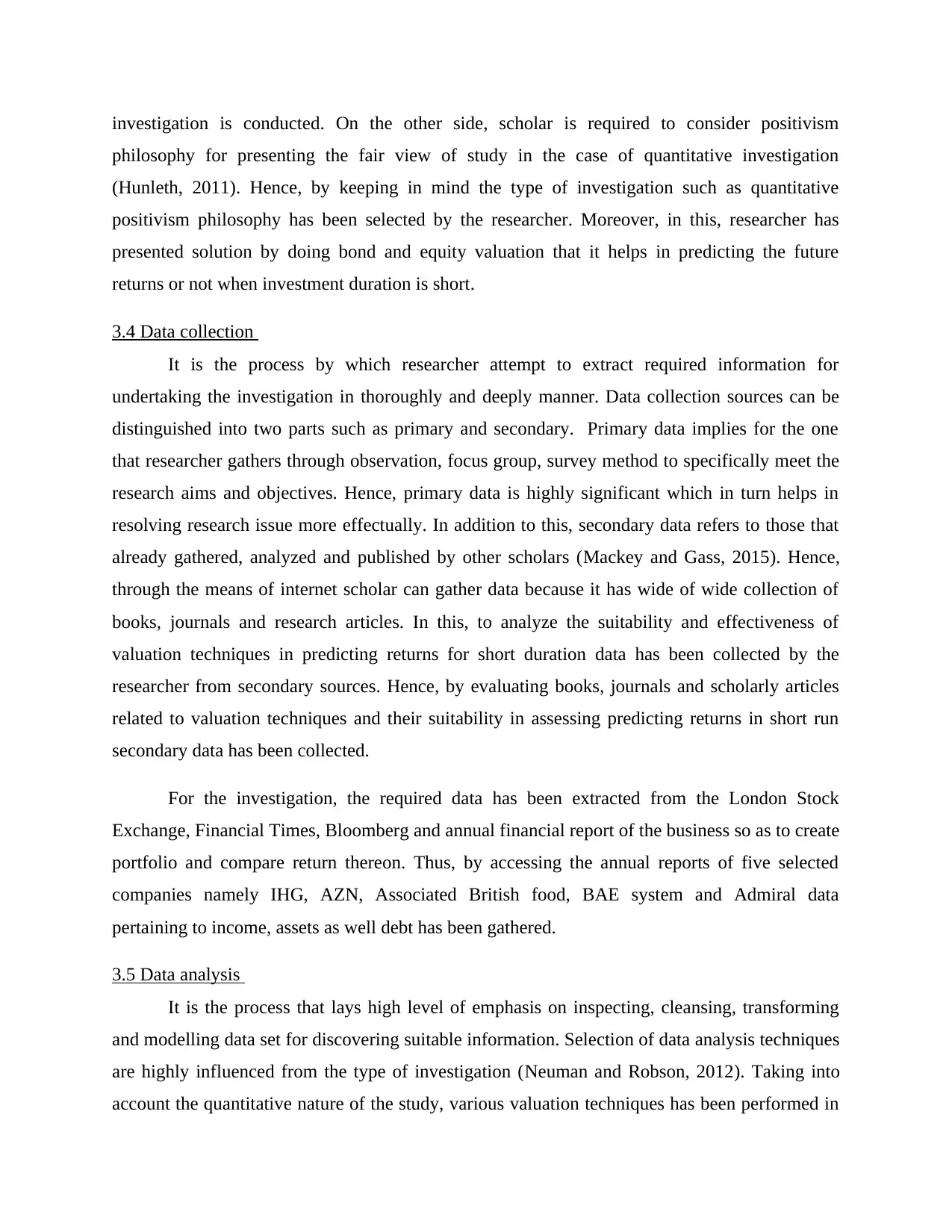
investigation is conducted. On the other side, scholar is required to consider positivism
philosophy for presenting the fair view of study in the case of quantitative investigation
(Hunleth, 2011). Hence, by keeping in mind the type of investigation such as quantitative
positivism philosophy has been selected by the researcher. Moreover, in this, researcher has
presented solution by doing bond and equity valuation that it helps in predicting the future
returns or not when investment duration is short.
3.4 Data collection
It is the process by which researcher attempt to extract required information for
undertaking the investigation in thoroughly and deeply manner. Data collection sources can be
distinguished into two parts such as primary and secondary. Primary data implies for the one
that researcher gathers through observation, focus group, survey method to specifically meet the
research aims and objectives. Hence, primary data is highly significant which in turn helps in
resolving research issue more effectually. In addition to this, secondary data refers to those that
already gathered, analyzed and published by other scholars (Mackey and Gass, 2015). Hence,
through the means of internet scholar can gather data because it has wide of wide collection of
books, journals and research articles. In this, to analyze the suitability and effectiveness of
valuation techniques in predicting returns for short duration data has been collected by the
researcher from secondary sources. Hence, by evaluating books, journals and scholarly articles
related to valuation techniques and their suitability in assessing predicting returns in short run
secondary data has been collected.
For the investigation, the required data has been extracted from the London Stock
Exchange, Financial Times, Bloomberg and annual financial report of the business so as to create
portfolio and compare return thereon. Thus, by accessing the annual reports of five selected
companies namely IHG, AZN, Associated British food, BAE system and Admiral data
pertaining to income, assets as well debt has been gathered.
3.5 Data analysis
It is the process that lays high level of emphasis on inspecting, cleansing, transforming
and modelling data set for discovering suitable information. Selection of data analysis techniques
are highly influenced from the type of investigation (Neuman and Robson, 2012). Taking into
account the quantitative nature of the study, various valuation techniques has been performed in
philosophy for presenting the fair view of study in the case of quantitative investigation
(Hunleth, 2011). Hence, by keeping in mind the type of investigation such as quantitative
positivism philosophy has been selected by the researcher. Moreover, in this, researcher has
presented solution by doing bond and equity valuation that it helps in predicting the future
returns or not when investment duration is short.
3.4 Data collection
It is the process by which researcher attempt to extract required information for
undertaking the investigation in thoroughly and deeply manner. Data collection sources can be
distinguished into two parts such as primary and secondary. Primary data implies for the one
that researcher gathers through observation, focus group, survey method to specifically meet the
research aims and objectives. Hence, primary data is highly significant which in turn helps in
resolving research issue more effectually. In addition to this, secondary data refers to those that
already gathered, analyzed and published by other scholars (Mackey and Gass, 2015). Hence,
through the means of internet scholar can gather data because it has wide of wide collection of
books, journals and research articles. In this, to analyze the suitability and effectiveness of
valuation techniques in predicting returns for short duration data has been collected by the
researcher from secondary sources. Hence, by evaluating books, journals and scholarly articles
related to valuation techniques and their suitability in assessing predicting returns in short run
secondary data has been collected.
For the investigation, the required data has been extracted from the London Stock
Exchange, Financial Times, Bloomberg and annual financial report of the business so as to create
portfolio and compare return thereon. Thus, by accessing the annual reports of five selected
companies namely IHG, AZN, Associated British food, BAE system and Admiral data
pertaining to income, assets as well debt has been gathered.
3.5 Data analysis
It is the process that lays high level of emphasis on inspecting, cleansing, transforming
and modelling data set for discovering suitable information. Selection of data analysis techniques
are highly influenced from the type of investigation (Neuman and Robson, 2012). Taking into
account the quantitative nature of the study, various valuation techniques has been performed in
Secure Best Marks with AI Grader
Need help grading? Try our AI Grader for instant feedback on your assignments.
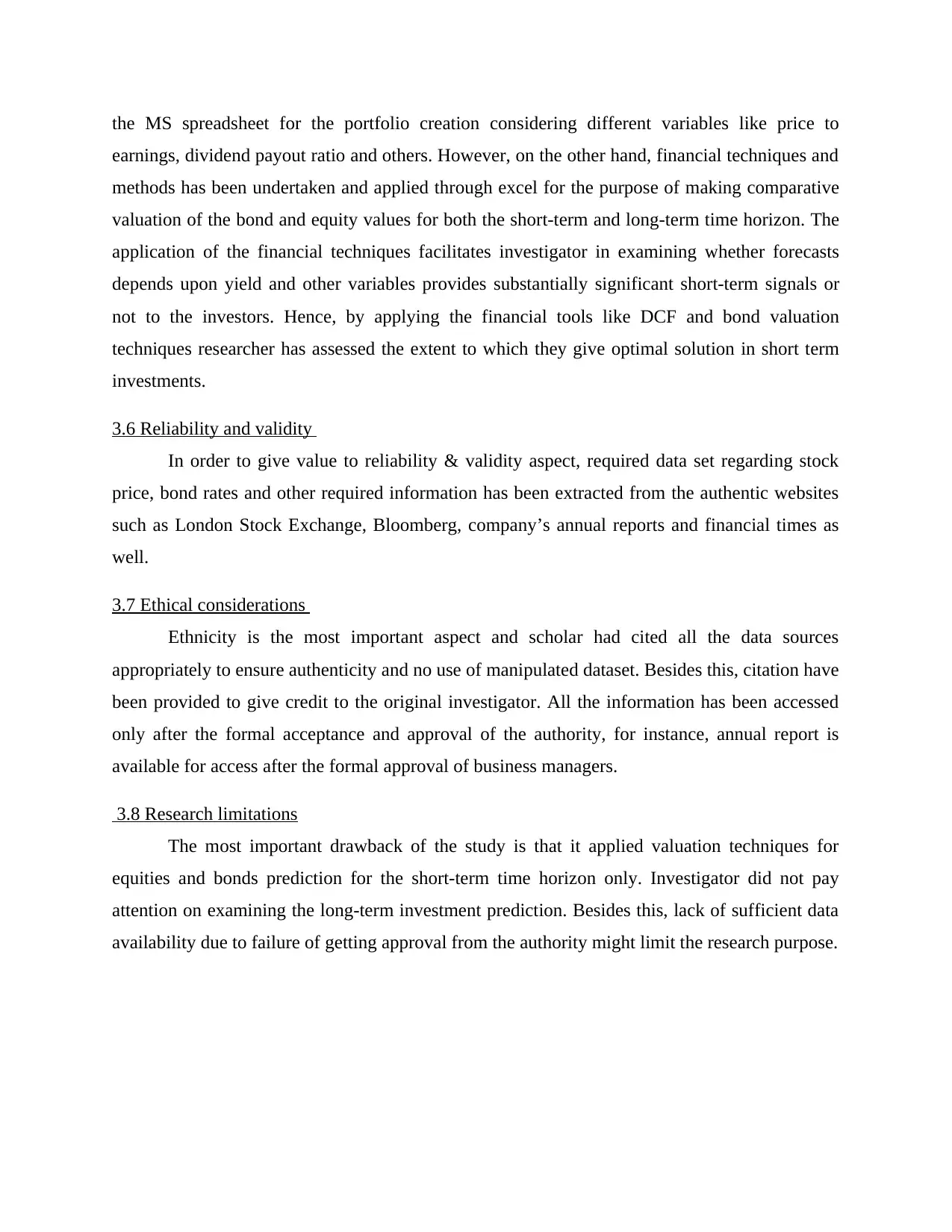
the MS spreadsheet for the portfolio creation considering different variables like price to
earnings, dividend payout ratio and others. However, on the other hand, financial techniques and
methods has been undertaken and applied through excel for the purpose of making comparative
valuation of the bond and equity values for both the short-term and long-term time horizon. The
application of the financial techniques facilitates investigator in examining whether forecasts
depends upon yield and other variables provides substantially significant short-term signals or
not to the investors. Hence, by applying the financial tools like DCF and bond valuation
techniques researcher has assessed the extent to which they give optimal solution in short term
investments.
3.6 Reliability and validity
In order to give value to reliability & validity aspect, required data set regarding stock
price, bond rates and other required information has been extracted from the authentic websites
such as London Stock Exchange, Bloomberg, company’s annual reports and financial times as
well.
3.7 Ethical considerations
Ethnicity is the most important aspect and scholar had cited all the data sources
appropriately to ensure authenticity and no use of manipulated dataset. Besides this, citation have
been provided to give credit to the original investigator. All the information has been accessed
only after the formal acceptance and approval of the authority, for instance, annual report is
available for access after the formal approval of business managers.
3.8 Research limitations
The most important drawback of the study is that it applied valuation techniques for
equities and bonds prediction for the short-term time horizon only. Investigator did not pay
attention on examining the long-term investment prediction. Besides this, lack of sufficient data
availability due to failure of getting approval from the authority might limit the research purpose.
earnings, dividend payout ratio and others. However, on the other hand, financial techniques and
methods has been undertaken and applied through excel for the purpose of making comparative
valuation of the bond and equity values for both the short-term and long-term time horizon. The
application of the financial techniques facilitates investigator in examining whether forecasts
depends upon yield and other variables provides substantially significant short-term signals or
not to the investors. Hence, by applying the financial tools like DCF and bond valuation
techniques researcher has assessed the extent to which they give optimal solution in short term
investments.
3.6 Reliability and validity
In order to give value to reliability & validity aspect, required data set regarding stock
price, bond rates and other required information has been extracted from the authentic websites
such as London Stock Exchange, Bloomberg, company’s annual reports and financial times as
well.
3.7 Ethical considerations
Ethnicity is the most important aspect and scholar had cited all the data sources
appropriately to ensure authenticity and no use of manipulated dataset. Besides this, citation have
been provided to give credit to the original investigator. All the information has been accessed
only after the formal acceptance and approval of the authority, for instance, annual report is
available for access after the formal approval of business managers.
3.8 Research limitations
The most important drawback of the study is that it applied valuation techniques for
equities and bonds prediction for the short-term time horizon only. Investigator did not pay
attention on examining the long-term investment prediction. Besides this, lack of sufficient data
availability due to failure of getting approval from the authority might limit the research purpose.
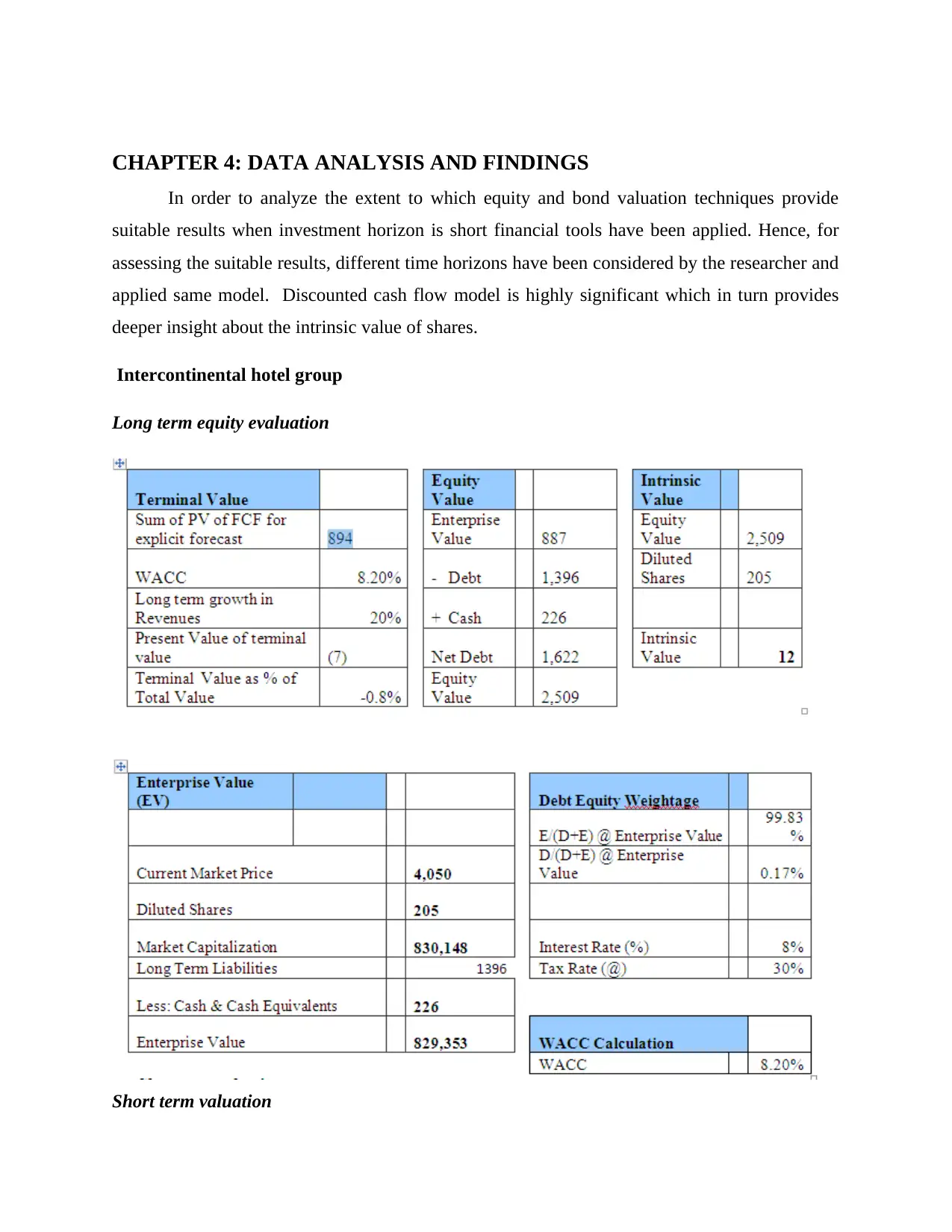
CHAPTER 4: DATA ANALYSIS AND FINDINGS
In order to analyze the extent to which equity and bond valuation techniques provide
suitable results when investment horizon is short financial tools have been applied. Hence, for
assessing the suitable results, different time horizons have been considered by the researcher and
applied same model. Discounted cash flow model is highly significant which in turn provides
deeper insight about the intrinsic value of shares.
Intercontinental hotel group
Long term equity evaluation
Short term valuation
In order to analyze the extent to which equity and bond valuation techniques provide
suitable results when investment horizon is short financial tools have been applied. Hence, for
assessing the suitable results, different time horizons have been considered by the researcher and
applied same model. Discounted cash flow model is highly significant which in turn provides
deeper insight about the intrinsic value of shares.
Intercontinental hotel group
Long term equity evaluation
Short term valuation
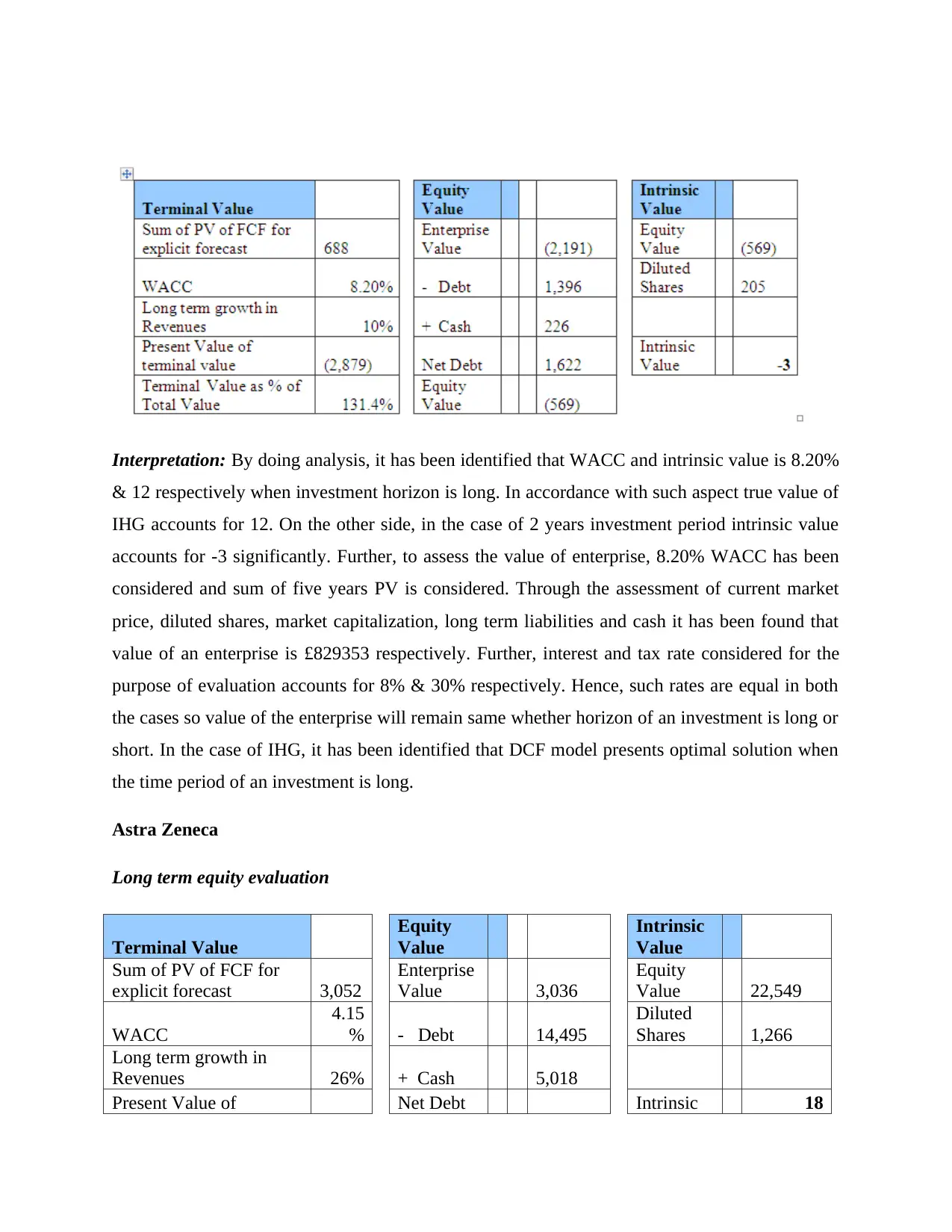
Interpretation: By doing analysis, it has been identified that WACC and intrinsic value is 8.20%
& 12 respectively when investment horizon is long. In accordance with such aspect true value of
IHG accounts for 12. On the other side, in the case of 2 years investment period intrinsic value
accounts for -3 significantly. Further, to assess the value of enterprise, 8.20% WACC has been
considered and sum of five years PV is considered. Through the assessment of current market
price, diluted shares, market capitalization, long term liabilities and cash it has been found that
value of an enterprise is £829353 respectively. Further, interest and tax rate considered for the
purpose of evaluation accounts for 8% & 30% respectively. Hence, such rates are equal in both
the cases so value of the enterprise will remain same whether horizon of an investment is long or
short. In the case of IHG, it has been identified that DCF model presents optimal solution when
the time period of an investment is long.
Astra Zeneca
Long term equity evaluation
Terminal Value
Equity
Value
Intrinsic
Value
Sum of PV of FCF for
explicit forecast 3,052
Enterprise
Value 3,036
Equity
Value 22,549
WACC
4.15
% - Debt 14,495
Diluted
Shares 1,266
Long term growth in
Revenues 26% + Cash 5,018
Present Value of Net Debt Intrinsic 18
& 12 respectively when investment horizon is long. In accordance with such aspect true value of
IHG accounts for 12. On the other side, in the case of 2 years investment period intrinsic value
accounts for -3 significantly. Further, to assess the value of enterprise, 8.20% WACC has been
considered and sum of five years PV is considered. Through the assessment of current market
price, diluted shares, market capitalization, long term liabilities and cash it has been found that
value of an enterprise is £829353 respectively. Further, interest and tax rate considered for the
purpose of evaluation accounts for 8% & 30% respectively. Hence, such rates are equal in both
the cases so value of the enterprise will remain same whether horizon of an investment is long or
short. In the case of IHG, it has been identified that DCF model presents optimal solution when
the time period of an investment is long.
Astra Zeneca
Long term equity evaluation
Terminal Value
Equity
Value
Intrinsic
Value
Sum of PV of FCF for
explicit forecast 3,052
Enterprise
Value 3,036
Equity
Value 22,549
WACC
4.15
% - Debt 14,495
Diluted
Shares 1,266
Long term growth in
Revenues 26% + Cash 5,018
Present Value of Net Debt Intrinsic 18
Paraphrase This Document
Need a fresh take? Get an instant paraphrase of this document with our AI Paraphraser
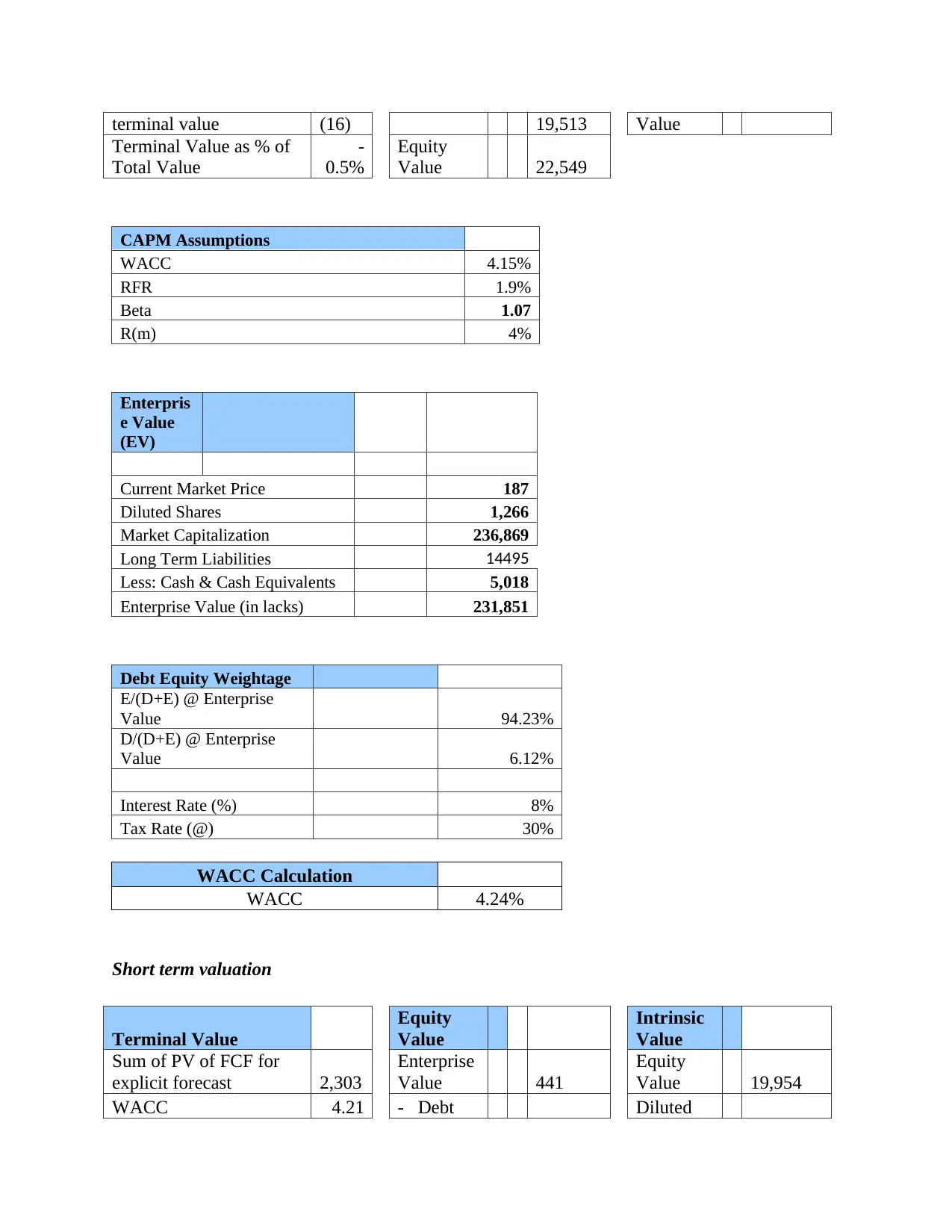
terminal value (16) 19,513 Value
Terminal Value as % of
Total Value
-
0.5%
Equity
Value 22,549
CAPM Assumptions
WACC 4.15%
RFR 1.9%
Beta 1.07
R(m) 4%
Enterpris
e Value
(EV)
Current Market Price 187
Diluted Shares 1,266
Market Capitalization 236,869
Long Term Liabilities 14495
Less: Cash & Cash Equivalents 5,018
Enterprise Value (in lacks) 231,851
Debt Equity Weightage
E/(D+E) @ Enterprise
Value 94.23%
D/(D+E) @ Enterprise
Value 6.12%
Interest Rate (%) 8%
Tax Rate (@) 30%
WACC Calculation
WACC 4.24%
Short term valuation
Terminal Value
Equity
Value
Intrinsic
Value
Sum of PV of FCF for
explicit forecast 2,303
Enterprise
Value 441
Equity
Value 19,954
WACC 4.21 - Debt Diluted
Terminal Value as % of
Total Value
-
0.5%
Equity
Value 22,549
CAPM Assumptions
WACC 4.15%
RFR 1.9%
Beta 1.07
R(m) 4%
Enterpris
e Value
(EV)
Current Market Price 187
Diluted Shares 1,266
Market Capitalization 236,869
Long Term Liabilities 14495
Less: Cash & Cash Equivalents 5,018
Enterprise Value (in lacks) 231,851
Debt Equity Weightage
E/(D+E) @ Enterprise
Value 94.23%
D/(D+E) @ Enterprise
Value 6.12%
Interest Rate (%) 8%
Tax Rate (@) 30%
WACC Calculation
WACC 4.24%
Short term valuation
Terminal Value
Equity
Value
Intrinsic
Value
Sum of PV of FCF for
explicit forecast 2,303
Enterprise
Value 441
Equity
Value 19,954
WACC 4.21 - Debt Diluted
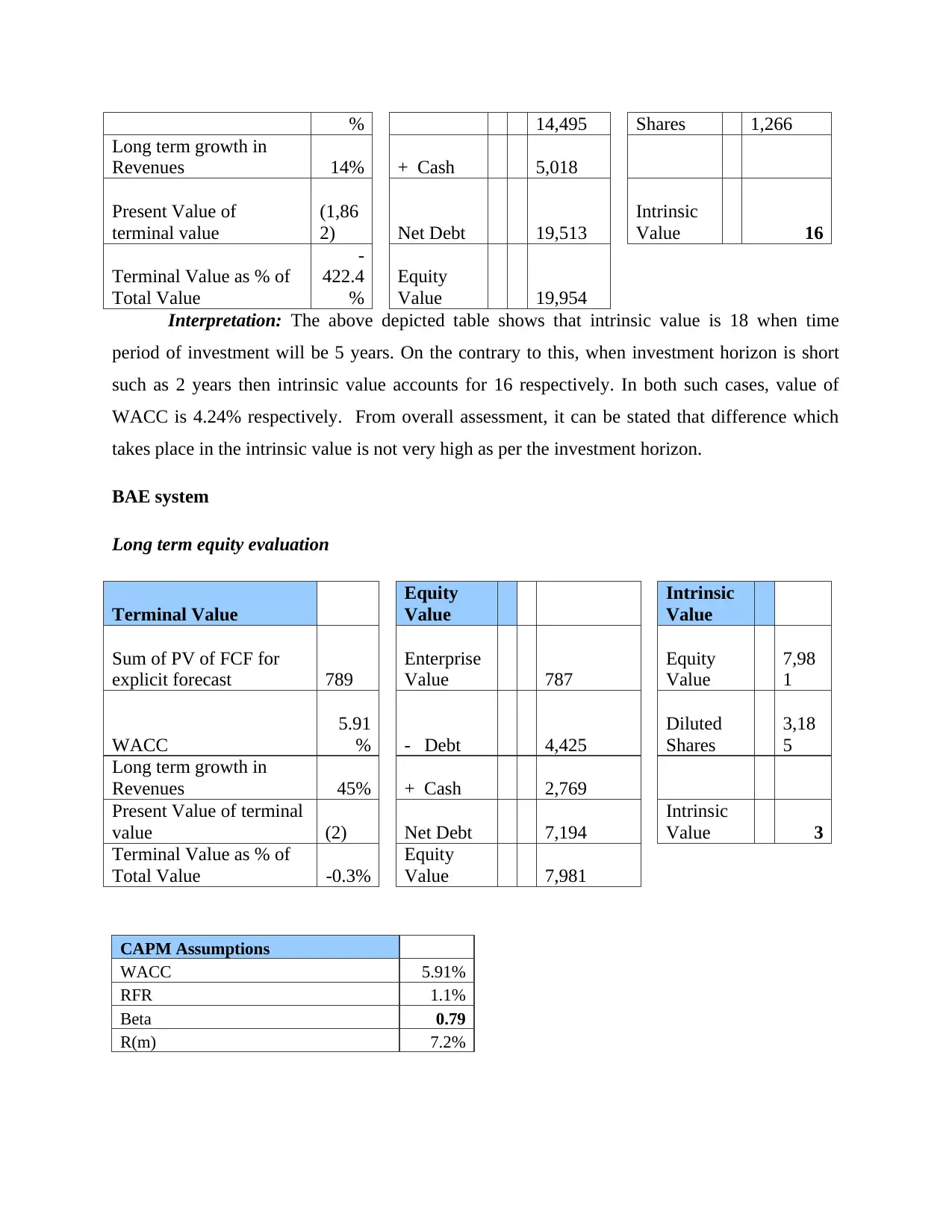
% 14,495 Shares 1,266
Long term growth in
Revenues 14% + Cash 5,018
Present Value of
terminal value
(1,86
2) Net Debt 19,513
Intrinsic
Value 16
Terminal Value as % of
Total Value
-
422.4
%
Equity
Value 19,954
Interpretation: The above depicted table shows that intrinsic value is 18 when time
period of investment will be 5 years. On the contrary to this, when investment horizon is short
such as 2 years then intrinsic value accounts for 16 respectively. In both such cases, value of
WACC is 4.24% respectively. From overall assessment, it can be stated that difference which
takes place in the intrinsic value is not very high as per the investment horizon.
BAE system
Long term equity evaluation
Terminal Value
Equity
Value
Intrinsic
Value
Sum of PV of FCF for
explicit forecast 789
Enterprise
Value 787
Equity
Value
7,98
1
WACC
5.91
% - Debt 4,425
Diluted
Shares
3,18
5
Long term growth in
Revenues 45% + Cash 2,769
Present Value of terminal
value (2) Net Debt 7,194
Intrinsic
Value 3
Terminal Value as % of
Total Value -0.3%
Equity
Value 7,981
CAPM Assumptions
WACC 5.91%
RFR 1.1%
Beta 0.79
R(m) 7.2%
Long term growth in
Revenues 14% + Cash 5,018
Present Value of
terminal value
(1,86
2) Net Debt 19,513
Intrinsic
Value 16
Terminal Value as % of
Total Value
-
422.4
%
Equity
Value 19,954
Interpretation: The above depicted table shows that intrinsic value is 18 when time
period of investment will be 5 years. On the contrary to this, when investment horizon is short
such as 2 years then intrinsic value accounts for 16 respectively. In both such cases, value of
WACC is 4.24% respectively. From overall assessment, it can be stated that difference which
takes place in the intrinsic value is not very high as per the investment horizon.
BAE system
Long term equity evaluation
Terminal Value
Equity
Value
Intrinsic
Value
Sum of PV of FCF for
explicit forecast 789
Enterprise
Value 787
Equity
Value
7,98
1
WACC
5.91
% - Debt 4,425
Diluted
Shares
3,18
5
Long term growth in
Revenues 45% + Cash 2,769
Present Value of terminal
value (2) Net Debt 7,194
Intrinsic
Value 3
Terminal Value as % of
Total Value -0.3%
Equity
Value 7,981
CAPM Assumptions
WACC 5.91%
RFR 1.1%
Beta 0.79
R(m) 7.2%
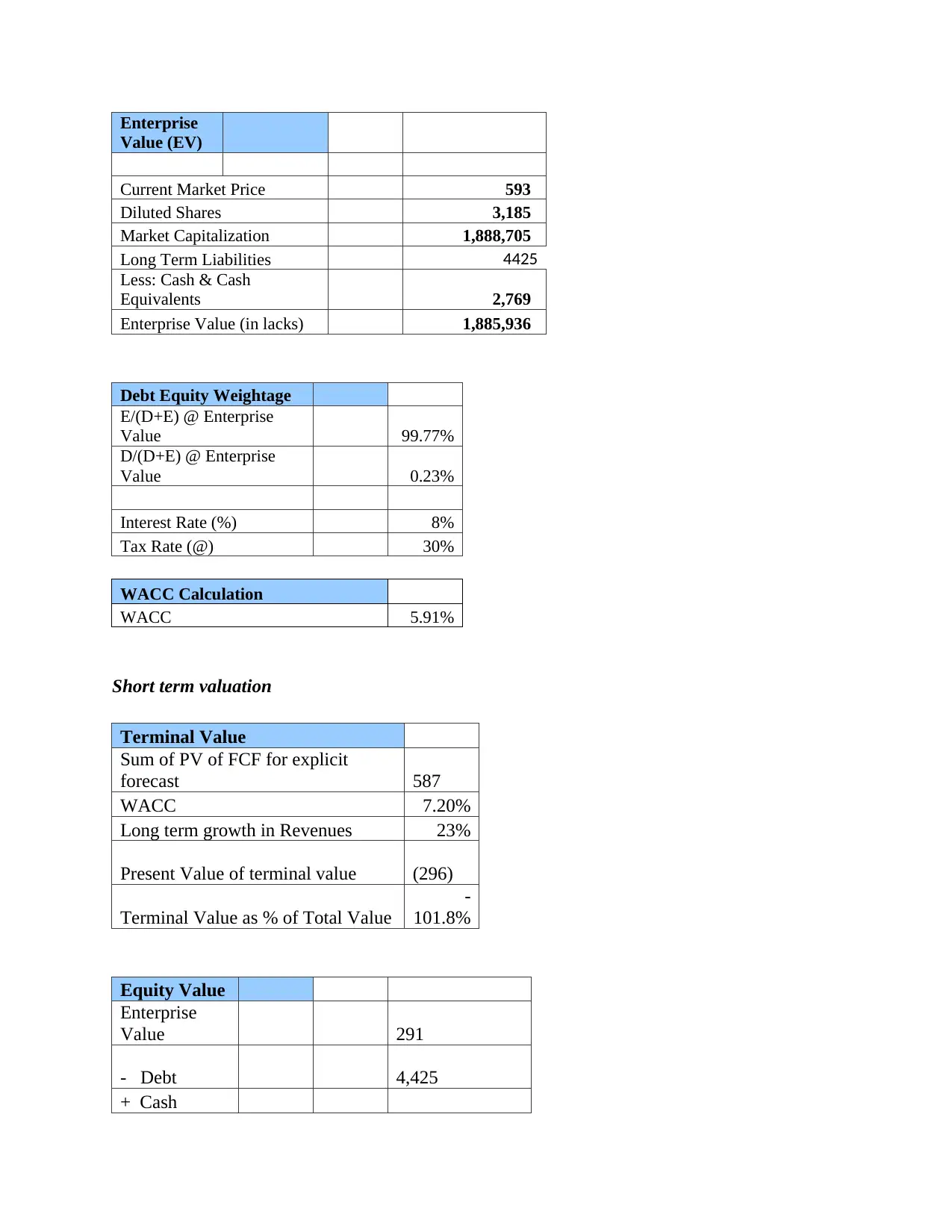
Enterprise
Value (EV)
Current Market Price 593
Diluted Shares 3,185
Market Capitalization 1,888,705
Long Term Liabilities 4425
Less: Cash & Cash
Equivalents 2,769
Enterprise Value (in lacks) 1,885,936
Debt Equity Weightage
E/(D+E) @ Enterprise
Value 99.77%
D/(D+E) @ Enterprise
Value 0.23%
Interest Rate (%) 8%
Tax Rate (@) 30%
WACC Calculation
WACC 5.91%
Short term valuation
Terminal Value
Sum of PV of FCF for explicit
forecast 587
WACC 7.20%
Long term growth in Revenues 23%
Present Value of terminal value (296)
Terminal Value as % of Total Value
-
101.8%
Equity Value
Enterprise
Value 291
- Debt 4,425
+ Cash
Value (EV)
Current Market Price 593
Diluted Shares 3,185
Market Capitalization 1,888,705
Long Term Liabilities 4425
Less: Cash & Cash
Equivalents 2,769
Enterprise Value (in lacks) 1,885,936
Debt Equity Weightage
E/(D+E) @ Enterprise
Value 99.77%
D/(D+E) @ Enterprise
Value 0.23%
Interest Rate (%) 8%
Tax Rate (@) 30%
WACC Calculation
WACC 5.91%
Short term valuation
Terminal Value
Sum of PV of FCF for explicit
forecast 587
WACC 7.20%
Long term growth in Revenues 23%
Present Value of terminal value (296)
Terminal Value as % of Total Value
-
101.8%
Equity Value
Enterprise
Value 291
- Debt 4,425
+ Cash
Secure Best Marks with AI Grader
Need help grading? Try our AI Grader for instant feedback on your assignments.
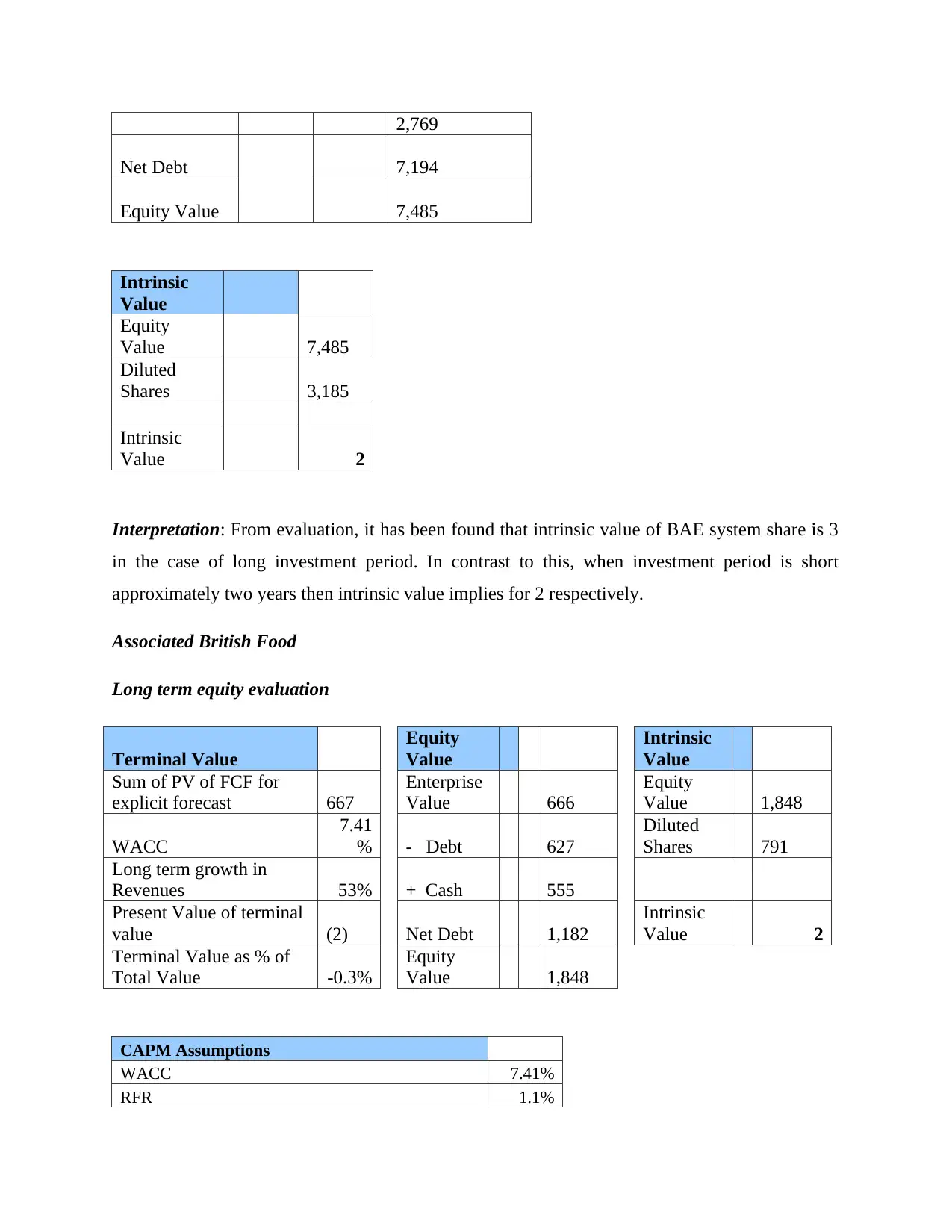
2,769
Net Debt 7,194
Equity Value 7,485
Intrinsic
Value
Equity
Value 7,485
Diluted
Shares 3,185
Intrinsic
Value 2
Interpretation: From evaluation, it has been found that intrinsic value of BAE system share is 3
in the case of long investment period. In contrast to this, when investment period is short
approximately two years then intrinsic value implies for 2 respectively.
Associated British Food
Long term equity evaluation
Terminal Value
Equity
Value
Intrinsic
Value
Sum of PV of FCF for
explicit forecast 667
Enterprise
Value 666
Equity
Value 1,848
WACC
7.41
% - Debt 627
Diluted
Shares 791
Long term growth in
Revenues 53% + Cash 555
Present Value of terminal
value (2) Net Debt 1,182
Intrinsic
Value 2
Terminal Value as % of
Total Value -0.3%
Equity
Value 1,848
CAPM Assumptions
WACC 7.41%
RFR 1.1%
Net Debt 7,194
Equity Value 7,485
Intrinsic
Value
Equity
Value 7,485
Diluted
Shares 3,185
Intrinsic
Value 2
Interpretation: From evaluation, it has been found that intrinsic value of BAE system share is 3
in the case of long investment period. In contrast to this, when investment period is short
approximately two years then intrinsic value implies for 2 respectively.
Associated British Food
Long term equity evaluation
Terminal Value
Equity
Value
Intrinsic
Value
Sum of PV of FCF for
explicit forecast 667
Enterprise
Value 666
Equity
Value 1,848
WACC
7.41
% - Debt 627
Diluted
Shares 791
Long term growth in
Revenues 53% + Cash 555
Present Value of terminal
value (2) Net Debt 1,182
Intrinsic
Value 2
Terminal Value as % of
Total Value -0.3%
Equity
Value 1,848
CAPM Assumptions
WACC 7.41%
RFR 1.1%
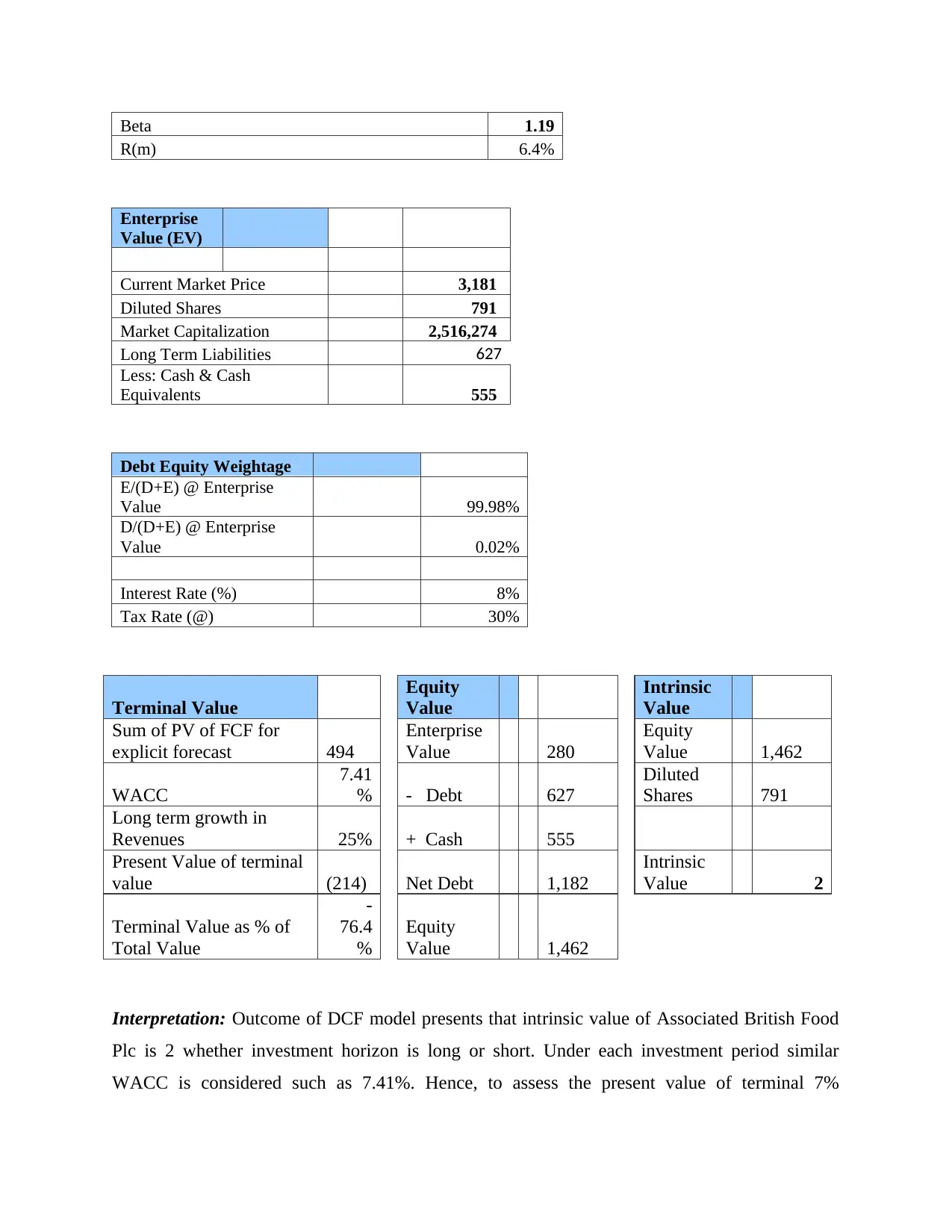
Beta 1.19
R(m) 6.4%
Enterprise
Value (EV)
Current Market Price 3,181
Diluted Shares 791
Market Capitalization 2,516,274
Long Term Liabilities 627
Less: Cash & Cash
Equivalents 555
Debt Equity Weightage
E/(D+E) @ Enterprise
Value 99.98%
D/(D+E) @ Enterprise
Value 0.02%
Interest Rate (%) 8%
Tax Rate (@) 30%
Terminal Value
Equity
Value
Intrinsic
Value
Sum of PV of FCF for
explicit forecast 494
Enterprise
Value 280
Equity
Value 1,462
WACC
7.41
% - Debt 627
Diluted
Shares 791
Long term growth in
Revenues 25% + Cash 555
Present Value of terminal
value (214) Net Debt 1,182
Intrinsic
Value 2
Terminal Value as % of
Total Value
-
76.4
%
Equity
Value 1,462
Interpretation: Outcome of DCF model presents that intrinsic value of Associated British Food
Plc is 2 whether investment horizon is long or short. Under each investment period similar
WACC is considered such as 7.41%. Hence, to assess the present value of terminal 7%
R(m) 6.4%
Enterprise
Value (EV)
Current Market Price 3,181
Diluted Shares 791
Market Capitalization 2,516,274
Long Term Liabilities 627
Less: Cash & Cash
Equivalents 555
Debt Equity Weightage
E/(D+E) @ Enterprise
Value 99.98%
D/(D+E) @ Enterprise
Value 0.02%
Interest Rate (%) 8%
Tax Rate (@) 30%
Terminal Value
Equity
Value
Intrinsic
Value
Sum of PV of FCF for
explicit forecast 494
Enterprise
Value 280
Equity
Value 1,462
WACC
7.41
% - Debt 627
Diluted
Shares 791
Long term growth in
Revenues 25% + Cash 555
Present Value of terminal
value (214) Net Debt 1,182
Intrinsic
Value 2
Terminal Value as % of
Total Value
-
76.4
%
Equity
Value 1,462
Interpretation: Outcome of DCF model presents that intrinsic value of Associated British Food
Plc is 2 whether investment horizon is long or short. Under each investment period similar
WACC is considered such as 7.41%. Hence, to assess the present value of terminal 7%
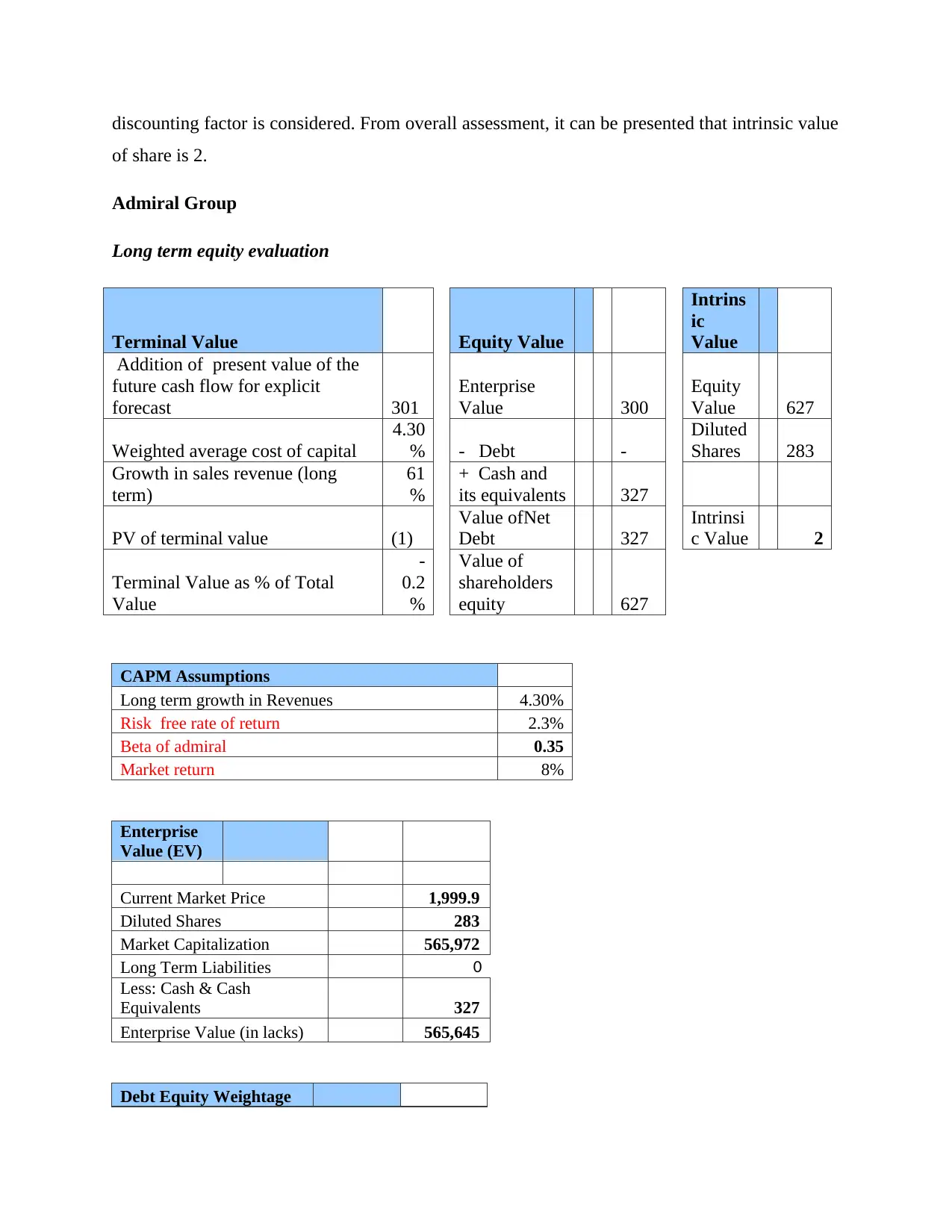
discounting factor is considered. From overall assessment, it can be presented that intrinsic value
of share is 2.
Admiral Group
Long term equity evaluation
Terminal Value Equity Value
Intrins
ic
Value
Addition of present value of the
future cash flow for explicit
forecast 301
Enterprise
Value 300
Equity
Value 627
Weighted average cost of capital
4.30
% - Debt -
Diluted
Shares 283
Growth in sales revenue (long
term)
61
%
+ Cash and
its equivalents 327
PV of terminal value (1)
Value ofNet
Debt 327
Intrinsi
c Value 2
Terminal Value as % of Total
Value
-
0.2
%
Value of
shareholders
equity 627
CAPM Assumptions
Long term growth in Revenues 4.30%
Risk free rate of return 2.3%
Beta of admiral 0.35
Market return 8%
Enterprise
Value (EV)
Current Market Price 1,999.9
Diluted Shares 283
Market Capitalization 565,972
Long Term Liabilities 0
Less: Cash & Cash
Equivalents 327
Enterprise Value (in lacks) 565,645
Debt Equity Weightage
of share is 2.
Admiral Group
Long term equity evaluation
Terminal Value Equity Value
Intrins
ic
Value
Addition of present value of the
future cash flow for explicit
forecast 301
Enterprise
Value 300
Equity
Value 627
Weighted average cost of capital
4.30
% - Debt -
Diluted
Shares 283
Growth in sales revenue (long
term)
61
%
+ Cash and
its equivalents 327
PV of terminal value (1)
Value ofNet
Debt 327
Intrinsi
c Value 2
Terminal Value as % of Total
Value
-
0.2
%
Value of
shareholders
equity 627
CAPM Assumptions
Long term growth in Revenues 4.30%
Risk free rate of return 2.3%
Beta of admiral 0.35
Market return 8%
Enterprise
Value (EV)
Current Market Price 1,999.9
Diluted Shares 283
Market Capitalization 565,972
Long Term Liabilities 0
Less: Cash & Cash
Equivalents 327
Enterprise Value (in lacks) 565,645
Debt Equity Weightage
Paraphrase This Document
Need a fresh take? Get an instant paraphrase of this document with our AI Paraphraser
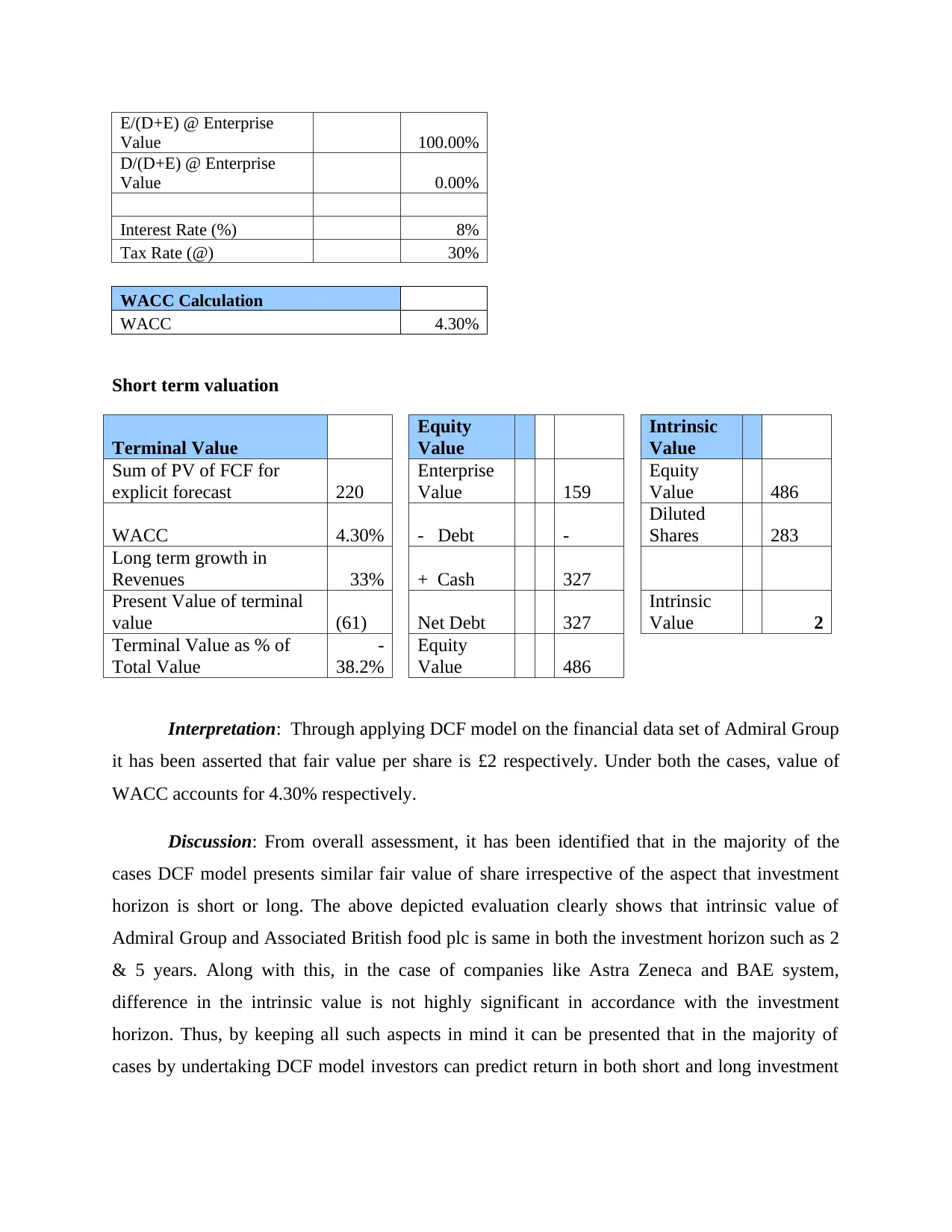
E/(D+E) @ Enterprise
Value 100.00%
D/(D+E) @ Enterprise
Value 0.00%
Interest Rate (%) 8%
Tax Rate (@) 30%
WACC Calculation
WACC 4.30%
Short term valuation
Terminal Value
Equity
Value
Intrinsic
Value
Sum of PV of FCF for
explicit forecast 220
Enterprise
Value 159
Equity
Value 486
WACC 4.30% - Debt -
Diluted
Shares 283
Long term growth in
Revenues 33% + Cash 327
Present Value of terminal
value (61) Net Debt 327
Intrinsic
Value 2
Terminal Value as % of
Total Value
-
38.2%
Equity
Value 486
Interpretation: Through applying DCF model on the financial data set of Admiral Group
it has been asserted that fair value per share is £2 respectively. Under both the cases, value of
WACC accounts for 4.30% respectively.
Discussion: From overall assessment, it has been identified that in the majority of the
cases DCF model presents similar fair value of share irrespective of the aspect that investment
horizon is short or long. The above depicted evaluation clearly shows that intrinsic value of
Admiral Group and Associated British food plc is same in both the investment horizon such as 2
& 5 years. Along with this, in the case of companies like Astra Zeneca and BAE system,
difference in the intrinsic value is not highly significant in accordance with the investment
horizon. Thus, by keeping all such aspects in mind it can be presented that in the majority of
cases by undertaking DCF model investors can predict return in both short and long investment
Value 100.00%
D/(D+E) @ Enterprise
Value 0.00%
Interest Rate (%) 8%
Tax Rate (@) 30%
WACC Calculation
WACC 4.30%
Short term valuation
Terminal Value
Equity
Value
Intrinsic
Value
Sum of PV of FCF for
explicit forecast 220
Enterprise
Value 159
Equity
Value 486
WACC 4.30% - Debt -
Diluted
Shares 283
Long term growth in
Revenues 33% + Cash 327
Present Value of terminal
value (61) Net Debt 327
Intrinsic
Value 2
Terminal Value as % of
Total Value
-
38.2%
Equity
Value 486
Interpretation: Through applying DCF model on the financial data set of Admiral Group
it has been asserted that fair value per share is £2 respectively. Under both the cases, value of
WACC accounts for 4.30% respectively.
Discussion: From overall assessment, it has been identified that in the majority of the
cases DCF model presents similar fair value of share irrespective of the aspect that investment
horizon is short or long. The above depicted evaluation clearly shows that intrinsic value of
Admiral Group and Associated British food plc is same in both the investment horizon such as 2
& 5 years. Along with this, in the case of companies like Astra Zeneca and BAE system,
difference in the intrinsic value is not highly significant in accordance with the investment
horizon. Thus, by keeping all such aspects in mind it can be presented that in the majority of
cases by undertaking DCF model investors can predict return in both short and long investment
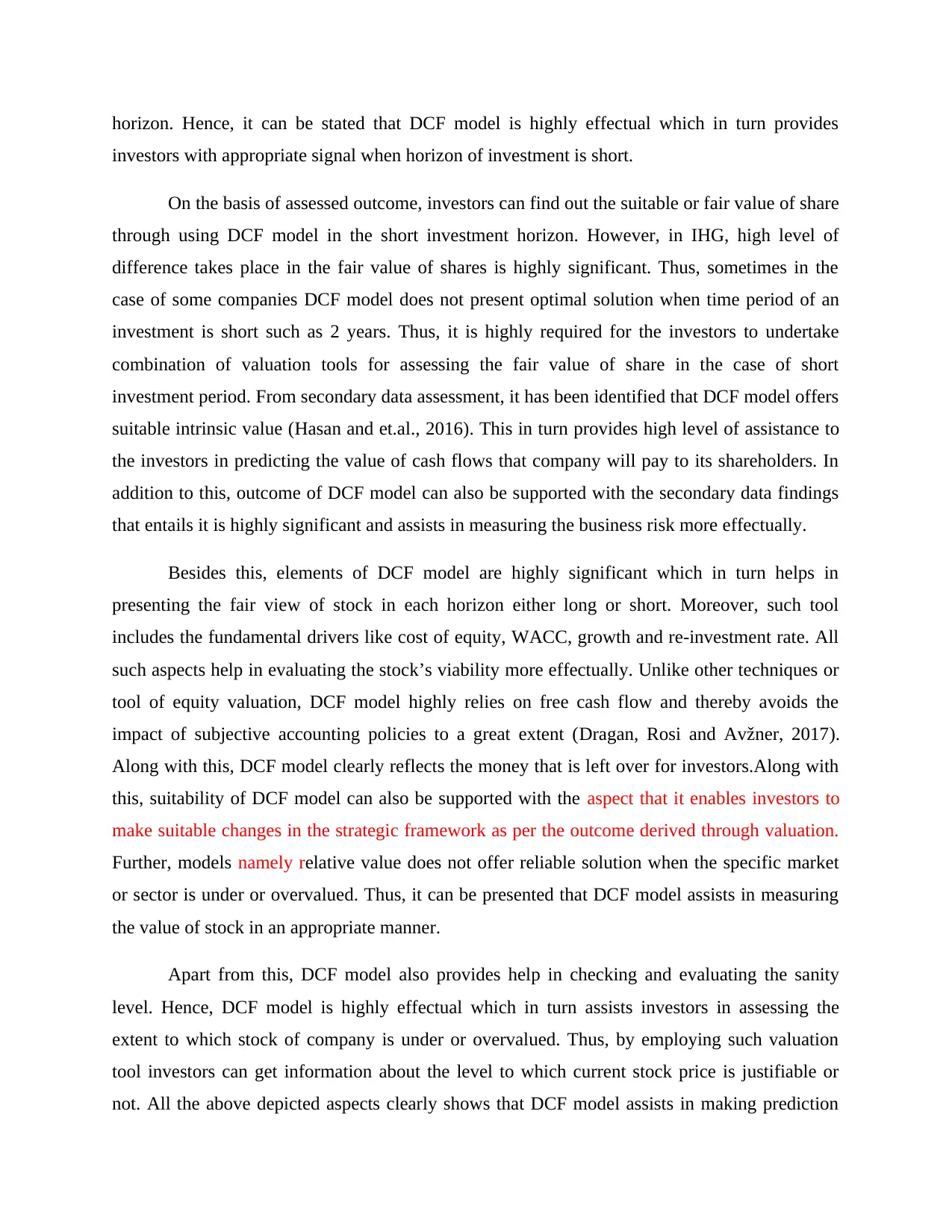
horizon. Hence, it can be stated that DCF model is highly effectual which in turn provides
investors with appropriate signal when horizon of investment is short.
On the basis of assessed outcome, investors can find out the suitable or fair value of share
through using DCF model in the short investment horizon. However, in IHG, high level of
difference takes place in the fair value of shares is highly significant. Thus, sometimes in the
case of some companies DCF model does not present optimal solution when time period of an
investment is short such as 2 years. Thus, it is highly required for the investors to undertake
combination of valuation tools for assessing the fair value of share in the case of short
investment period. From secondary data assessment, it has been identified that DCF model offers
suitable intrinsic value (Hasan and et.al., 2016). This in turn provides high level of assistance to
the investors in predicting the value of cash flows that company will pay to its shareholders. In
addition to this, outcome of DCF model can also be supported with the secondary data findings
that entails it is highly significant and assists in measuring the business risk more effectually.
Besides this, elements of DCF model are highly significant which in turn helps in
presenting the fair view of stock in each horizon either long or short. Moreover, such tool
includes the fundamental drivers like cost of equity, WACC, growth and re-investment rate. All
such aspects help in evaluating the stock’s viability more effectually. Unlike other techniques or
tool of equity valuation, DCF model highly relies on free cash flow and thereby avoids the
impact of subjective accounting policies to a great extent (Dragan, Rosi and Avžner, 2017).
Along with this, DCF model clearly reflects the money that is left over for investors.Along with
this, suitability of DCF model can also be supported with the aspect that it enables investors to
make suitable changes in the strategic framework as per the outcome derived through valuation.
Further, models namely relative value does not offer reliable solution when the specific market
or sector is under or overvalued. Thus, it can be presented that DCF model assists in measuring
the value of stock in an appropriate manner.
Apart from this, DCF model also provides help in checking and evaluating the sanity
level. Hence, DCF model is highly effectual which in turn assists investors in assessing the
extent to which stock of company is under or overvalued. Thus, by employing such valuation
tool investors can get information about the level to which current stock price is justifiable or
not. All the above depicted aspects clearly shows that DCF model assists in making prediction
investors with appropriate signal when horizon of investment is short.
On the basis of assessed outcome, investors can find out the suitable or fair value of share
through using DCF model in the short investment horizon. However, in IHG, high level of
difference takes place in the fair value of shares is highly significant. Thus, sometimes in the
case of some companies DCF model does not present optimal solution when time period of an
investment is short such as 2 years. Thus, it is highly required for the investors to undertake
combination of valuation tools for assessing the fair value of share in the case of short
investment period. From secondary data assessment, it has been identified that DCF model offers
suitable intrinsic value (Hasan and et.al., 2016). This in turn provides high level of assistance to
the investors in predicting the value of cash flows that company will pay to its shareholders. In
addition to this, outcome of DCF model can also be supported with the secondary data findings
that entails it is highly significant and assists in measuring the business risk more effectually.
Besides this, elements of DCF model are highly significant which in turn helps in
presenting the fair view of stock in each horizon either long or short. Moreover, such tool
includes the fundamental drivers like cost of equity, WACC, growth and re-investment rate. All
such aspects help in evaluating the stock’s viability more effectually. Unlike other techniques or
tool of equity valuation, DCF model highly relies on free cash flow and thereby avoids the
impact of subjective accounting policies to a great extent (Dragan, Rosi and Avžner, 2017).
Along with this, DCF model clearly reflects the money that is left over for investors.Along with
this, suitability of DCF model can also be supported with the aspect that it enables investors to
make suitable changes in the strategic framework as per the outcome derived through valuation.
Further, models namely relative value does not offer reliable solution when the specific market
or sector is under or overvalued. Thus, it can be presented that DCF model assists in measuring
the value of stock in an appropriate manner.
Apart from this, DCF model also provides help in checking and evaluating the sanity
level. Hence, DCF model is highly effectual which in turn assists investors in assessing the
extent to which stock of company is under or overvalued. Thus, by employing such valuation
tool investors can get information about the level to which current stock price is justifiable or
not. All the above depicted aspects clearly shows that DCF model assists in making prediction
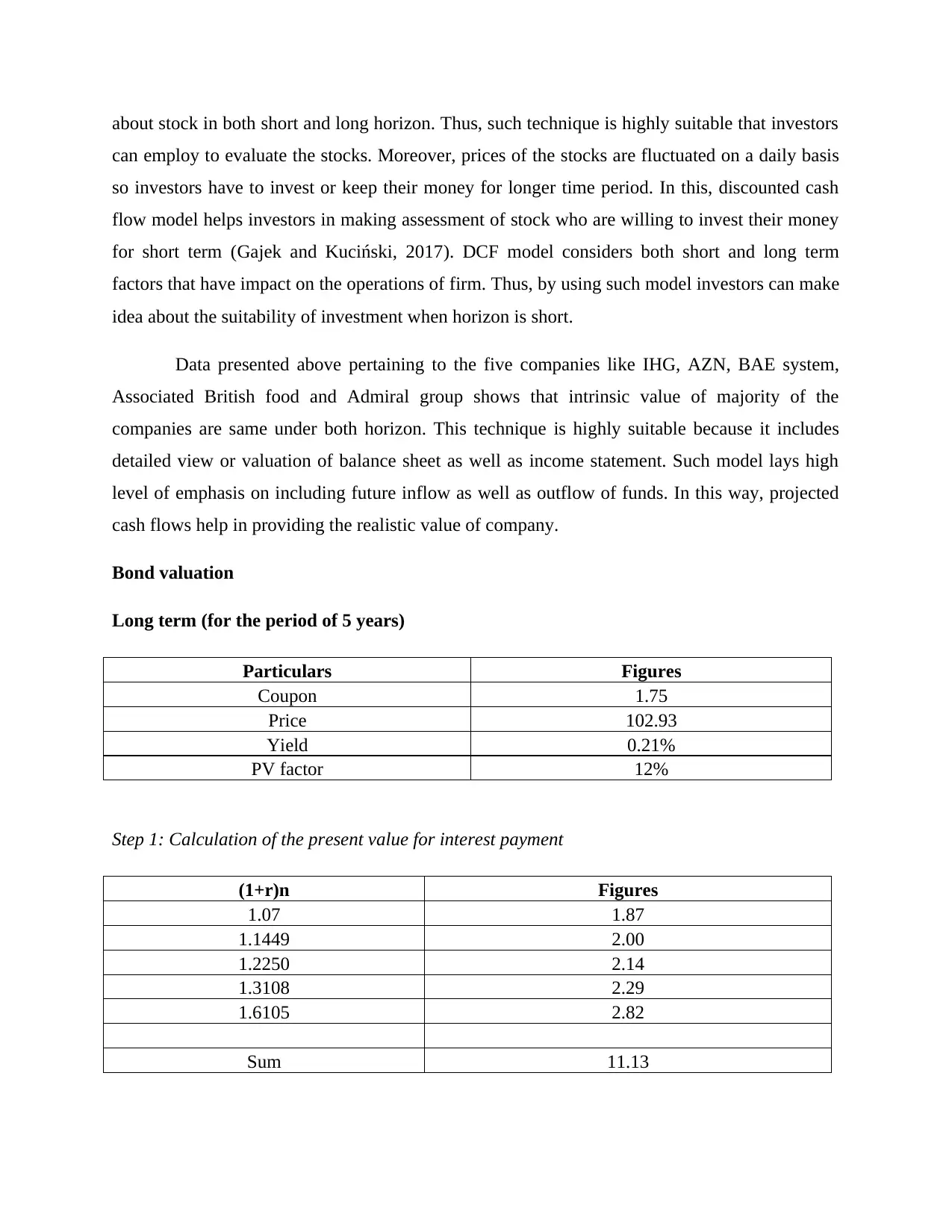
about stock in both short and long horizon. Thus, such technique is highly suitable that investors
can employ to evaluate the stocks. Moreover, prices of the stocks are fluctuated on a daily basis
so investors have to invest or keep their money for longer time period. In this, discounted cash
flow model helps investors in making assessment of stock who are willing to invest their money
for short term (Gajek and Kuciński, 2017). DCF model considers both short and long term
factors that have impact on the operations of firm. Thus, by using such model investors can make
idea about the suitability of investment when horizon is short.
Data presented above pertaining to the five companies like IHG, AZN, BAE system,
Associated British food and Admiral group shows that intrinsic value of majority of the
companies are same under both horizon. This technique is highly suitable because it includes
detailed view or valuation of balance sheet as well as income statement. Such model lays high
level of emphasis on including future inflow as well as outflow of funds. In this way, projected
cash flows help in providing the realistic value of company.
Bond valuation
Long term (for the period of 5 years)
Particulars Figures
Coupon 1.75
Price 102.93
Yield 0.21%
PV factor 12%
Step 1: Calculation of the present value for interest payment
(1+r)n Figures
1.07 1.87
1.1449 2.00
1.2250 2.14
1.3108 2.29
1.6105 2.82
Sum 11.13
can employ to evaluate the stocks. Moreover, prices of the stocks are fluctuated on a daily basis
so investors have to invest or keep their money for longer time period. In this, discounted cash
flow model helps investors in making assessment of stock who are willing to invest their money
for short term (Gajek and Kuciński, 2017). DCF model considers both short and long term
factors that have impact on the operations of firm. Thus, by using such model investors can make
idea about the suitability of investment when horizon is short.
Data presented above pertaining to the five companies like IHG, AZN, BAE system,
Associated British food and Admiral group shows that intrinsic value of majority of the
companies are same under both horizon. This technique is highly suitable because it includes
detailed view or valuation of balance sheet as well as income statement. Such model lays high
level of emphasis on including future inflow as well as outflow of funds. In this way, projected
cash flows help in providing the realistic value of company.
Bond valuation
Long term (for the period of 5 years)
Particulars Figures
Coupon 1.75
Price 102.93
Yield 0.21%
PV factor 12%
Step 1: Calculation of the present value for interest payment
(1+r)n Figures
1.07 1.87
1.1449 2.00
1.2250 2.14
1.3108 2.29
1.6105 2.82
Sum 11.13
Secure Best Marks with AI Grader
Need help grading? Try our AI Grader for instant feedback on your assignments.
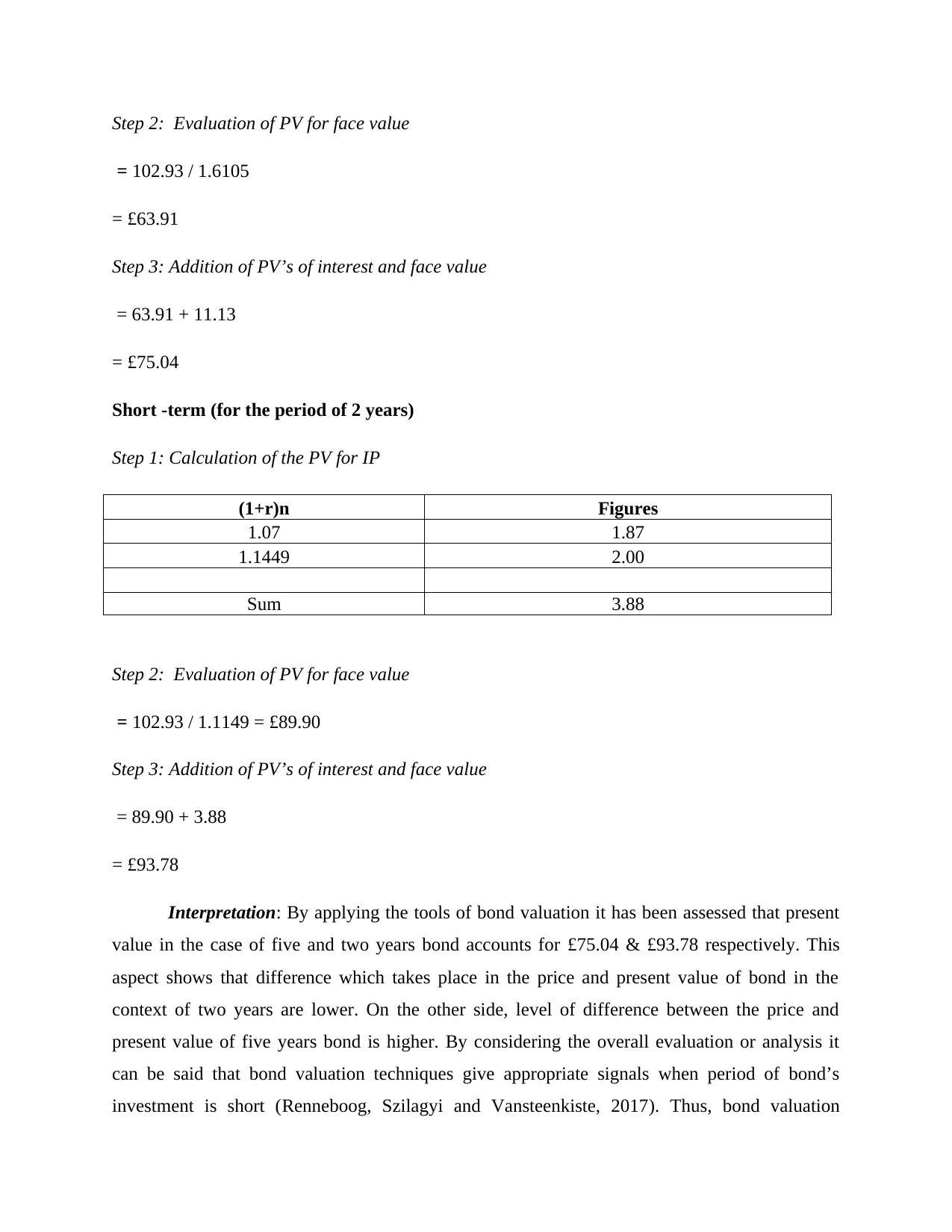
Step 2: Evaluation of PV for face value
= 102.93 / 1.6105
= £63.91
Step 3: Addition of PV’s of interest and face value
= 63.91 + 11.13
= £75.04
Short -term (for the period of 2 years)
Step 1: Calculation of the PV for IP
(1+r)n Figures
1.07 1.87
1.1449 2.00
Sum 3.88
Step 2: Evaluation of PV for face value
= 102.93 / 1.1149 = £89.90
Step 3: Addition of PV’s of interest and face value
= 89.90 + 3.88
= £93.78
Interpretation: By applying the tools of bond valuation it has been assessed that present
value in the case of five and two years bond accounts for £75.04 & £93.78 respectively. This
aspect shows that difference which takes place in the price and present value of bond in the
context of two years are lower. On the other side, level of difference between the price and
present value of five years bond is higher. By considering the overall evaluation or analysis it
can be said that bond valuation techniques give appropriate signals when period of bond’s
investment is short (Renneboog, Szilagyi and Vansteenkiste, 2017). Thus, bond valuation
= 102.93 / 1.6105
= £63.91
Step 3: Addition of PV’s of interest and face value
= 63.91 + 11.13
= £75.04
Short -term (for the period of 2 years)
Step 1: Calculation of the PV for IP
(1+r)n Figures
1.07 1.87
1.1449 2.00
Sum 3.88
Step 2: Evaluation of PV for face value
= 102.93 / 1.1149 = £89.90
Step 3: Addition of PV’s of interest and face value
= 89.90 + 3.88
= £93.78
Interpretation: By applying the tools of bond valuation it has been assessed that present
value in the case of five and two years bond accounts for £75.04 & £93.78 respectively. This
aspect shows that difference which takes place in the price and present value of bond in the
context of two years are lower. On the other side, level of difference between the price and
present value of five years bond is higher. By considering the overall evaluation or analysis it
can be said that bond valuation techniques give appropriate signals when period of bond’s
investment is short (Renneboog, Szilagyi and Vansteenkiste, 2017). Thus, bond valuation
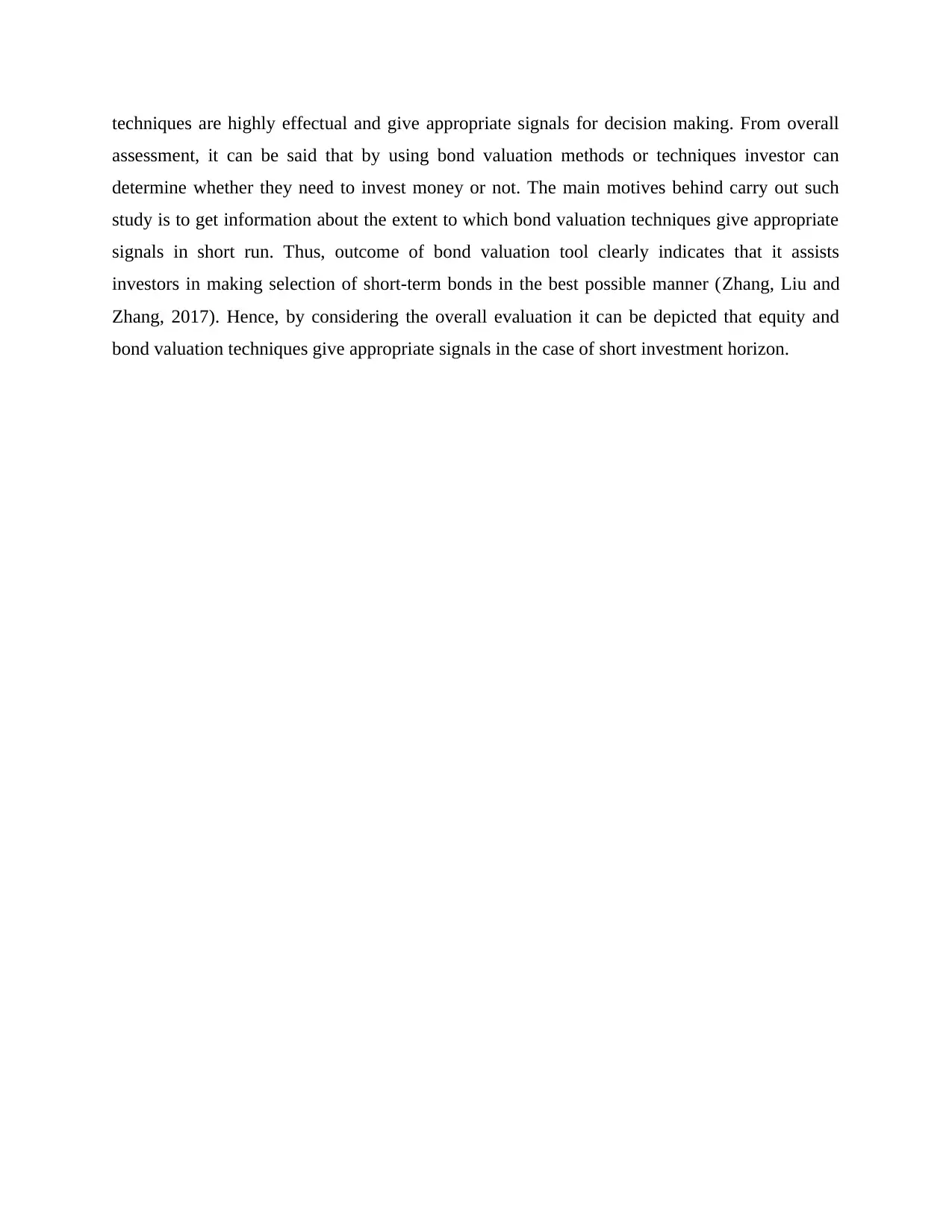
techniques are highly effectual and give appropriate signals for decision making. From overall
assessment, it can be said that by using bond valuation methods or techniques investor can
determine whether they need to invest money or not. The main motives behind carry out such
study is to get information about the extent to which bond valuation techniques give appropriate
signals in short run. Thus, outcome of bond valuation tool clearly indicates that it assists
investors in making selection of short-term bonds in the best possible manner (Zhang, Liu and
Zhang, 2017). Hence, by considering the overall evaluation it can be depicted that equity and
bond valuation techniques give appropriate signals in the case of short investment horizon.
assessment, it can be said that by using bond valuation methods or techniques investor can
determine whether they need to invest money or not. The main motives behind carry out such
study is to get information about the extent to which bond valuation techniques give appropriate
signals in short run. Thus, outcome of bond valuation tool clearly indicates that it assists
investors in making selection of short-term bonds in the best possible manner (Zhang, Liu and
Zhang, 2017). Hence, by considering the overall evaluation it can be depicted that equity and
bond valuation techniques give appropriate signals in the case of short investment horizon.
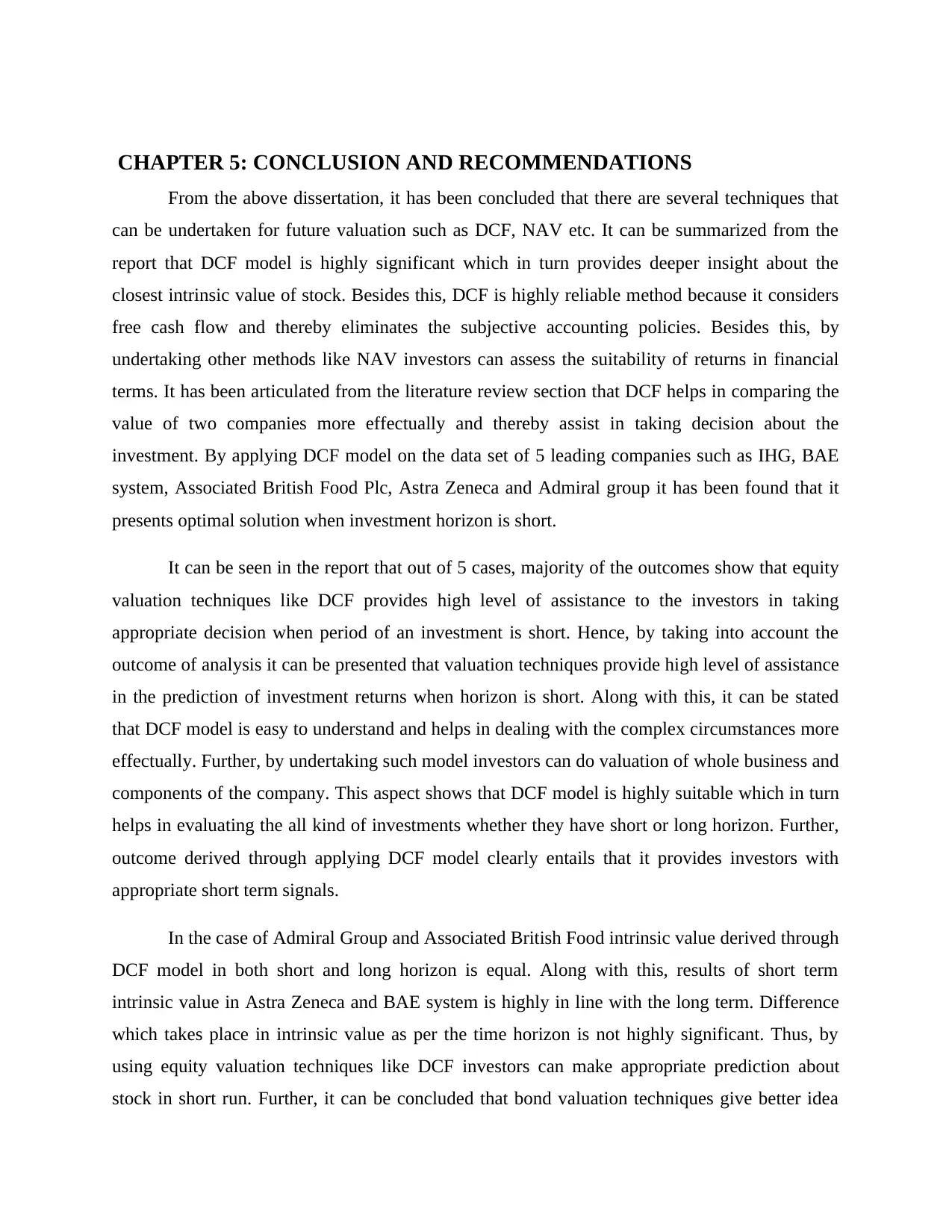
CHAPTER 5: CONCLUSION AND RECOMMENDATIONS
From the above dissertation, it has been concluded that there are several techniques that
can be undertaken for future valuation such as DCF, NAV etc. It can be summarized from the
report that DCF model is highly significant which in turn provides deeper insight about the
closest intrinsic value of stock. Besides this, DCF is highly reliable method because it considers
free cash flow and thereby eliminates the subjective accounting policies. Besides this, by
undertaking other methods like NAV investors can assess the suitability of returns in financial
terms. It has been articulated from the literature review section that DCF helps in comparing the
value of two companies more effectually and thereby assist in taking decision about the
investment. By applying DCF model on the data set of 5 leading companies such as IHG, BAE
system, Associated British Food Plc, Astra Zeneca and Admiral group it has been found that it
presents optimal solution when investment horizon is short.
It can be seen in the report that out of 5 cases, majority of the outcomes show that equity
valuation techniques like DCF provides high level of assistance to the investors in taking
appropriate decision when period of an investment is short. Hence, by taking into account the
outcome of analysis it can be presented that valuation techniques provide high level of assistance
in the prediction of investment returns when horizon is short. Along with this, it can be stated
that DCF model is easy to understand and helps in dealing with the complex circumstances more
effectually. Further, by undertaking such model investors can do valuation of whole business and
components of the company. This aspect shows that DCF model is highly suitable which in turn
helps in evaluating the all kind of investments whether they have short or long horizon. Further,
outcome derived through applying DCF model clearly entails that it provides investors with
appropriate short term signals.
In the case of Admiral Group and Associated British Food intrinsic value derived through
DCF model in both short and long horizon is equal. Along with this, results of short term
intrinsic value in Astra Zeneca and BAE system is highly in line with the long term. Difference
which takes place in intrinsic value as per the time horizon is not highly significant. Thus, by
using equity valuation techniques like DCF investors can make appropriate prediction about
stock in short run. Further, it can be concluded that bond valuation techniques give better idea
From the above dissertation, it has been concluded that there are several techniques that
can be undertaken for future valuation such as DCF, NAV etc. It can be summarized from the
report that DCF model is highly significant which in turn provides deeper insight about the
closest intrinsic value of stock. Besides this, DCF is highly reliable method because it considers
free cash flow and thereby eliminates the subjective accounting policies. Besides this, by
undertaking other methods like NAV investors can assess the suitability of returns in financial
terms. It has been articulated from the literature review section that DCF helps in comparing the
value of two companies more effectually and thereby assist in taking decision about the
investment. By applying DCF model on the data set of 5 leading companies such as IHG, BAE
system, Associated British Food Plc, Astra Zeneca and Admiral group it has been found that it
presents optimal solution when investment horizon is short.
It can be seen in the report that out of 5 cases, majority of the outcomes show that equity
valuation techniques like DCF provides high level of assistance to the investors in taking
appropriate decision when period of an investment is short. Hence, by taking into account the
outcome of analysis it can be presented that valuation techniques provide high level of assistance
in the prediction of investment returns when horizon is short. Along with this, it can be stated
that DCF model is easy to understand and helps in dealing with the complex circumstances more
effectually. Further, by undertaking such model investors can do valuation of whole business and
components of the company. This aspect shows that DCF model is highly suitable which in turn
helps in evaluating the all kind of investments whether they have short or long horizon. Further,
outcome derived through applying DCF model clearly entails that it provides investors with
appropriate short term signals.
In the case of Admiral Group and Associated British Food intrinsic value derived through
DCF model in both short and long horizon is equal. Along with this, results of short term
intrinsic value in Astra Zeneca and BAE system is highly in line with the long term. Difference
which takes place in intrinsic value as per the time horizon is not highly significant. Thus, by
using equity valuation techniques like DCF investors can make appropriate prediction about
stock in short run. Further, it can be concluded that bond valuation techniques give better idea
Paraphrase This Document
Need a fresh take? Get an instant paraphrase of this document with our AI Paraphraser
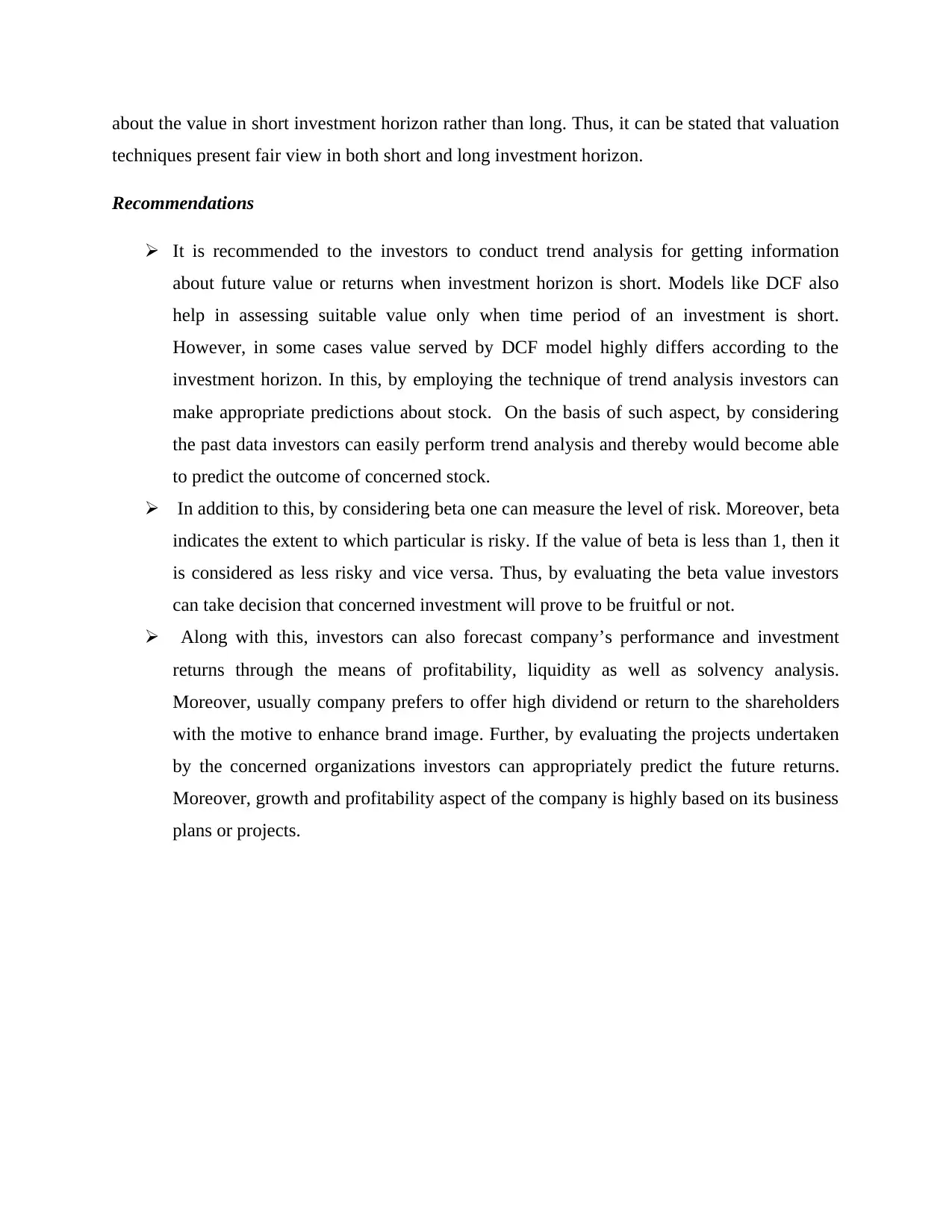
about the value in short investment horizon rather than long. Thus, it can be stated that valuation
techniques present fair view in both short and long investment horizon.
Recommendations
It is recommended to the investors to conduct trend analysis for getting information
about future value or returns when investment horizon is short. Models like DCF also
help in assessing suitable value only when time period of an investment is short.
However, in some cases value served by DCF model highly differs according to the
investment horizon. In this, by employing the technique of trend analysis investors can
make appropriate predictions about stock. On the basis of such aspect, by considering
the past data investors can easily perform trend analysis and thereby would become able
to predict the outcome of concerned stock.
In addition to this, by considering beta one can measure the level of risk. Moreover, beta
indicates the extent to which particular is risky. If the value of beta is less than 1, then it
is considered as less risky and vice versa. Thus, by evaluating the beta value investors
can take decision that concerned investment will prove to be fruitful or not.
Along with this, investors can also forecast company’s performance and investment
returns through the means of profitability, liquidity as well as solvency analysis.
Moreover, usually company prefers to offer high dividend or return to the shareholders
with the motive to enhance brand image. Further, by evaluating the projects undertaken
by the concerned organizations investors can appropriately predict the future returns.
Moreover, growth and profitability aspect of the company is highly based on its business
plans or projects.
techniques present fair view in both short and long investment horizon.
Recommendations
It is recommended to the investors to conduct trend analysis for getting information
about future value or returns when investment horizon is short. Models like DCF also
help in assessing suitable value only when time period of an investment is short.
However, in some cases value served by DCF model highly differs according to the
investment horizon. In this, by employing the technique of trend analysis investors can
make appropriate predictions about stock. On the basis of such aspect, by considering
the past data investors can easily perform trend analysis and thereby would become able
to predict the outcome of concerned stock.
In addition to this, by considering beta one can measure the level of risk. Moreover, beta
indicates the extent to which particular is risky. If the value of beta is less than 1, then it
is considered as less risky and vice versa. Thus, by evaluating the beta value investors
can take decision that concerned investment will prove to be fruitful or not.
Along with this, investors can also forecast company’s performance and investment
returns through the means of profitability, liquidity as well as solvency analysis.
Moreover, usually company prefers to offer high dividend or return to the shareholders
with the motive to enhance brand image. Further, by evaluating the projects undertaken
by the concerned organizations investors can appropriately predict the future returns.
Moreover, growth and profitability aspect of the company is highly based on its business
plans or projects.
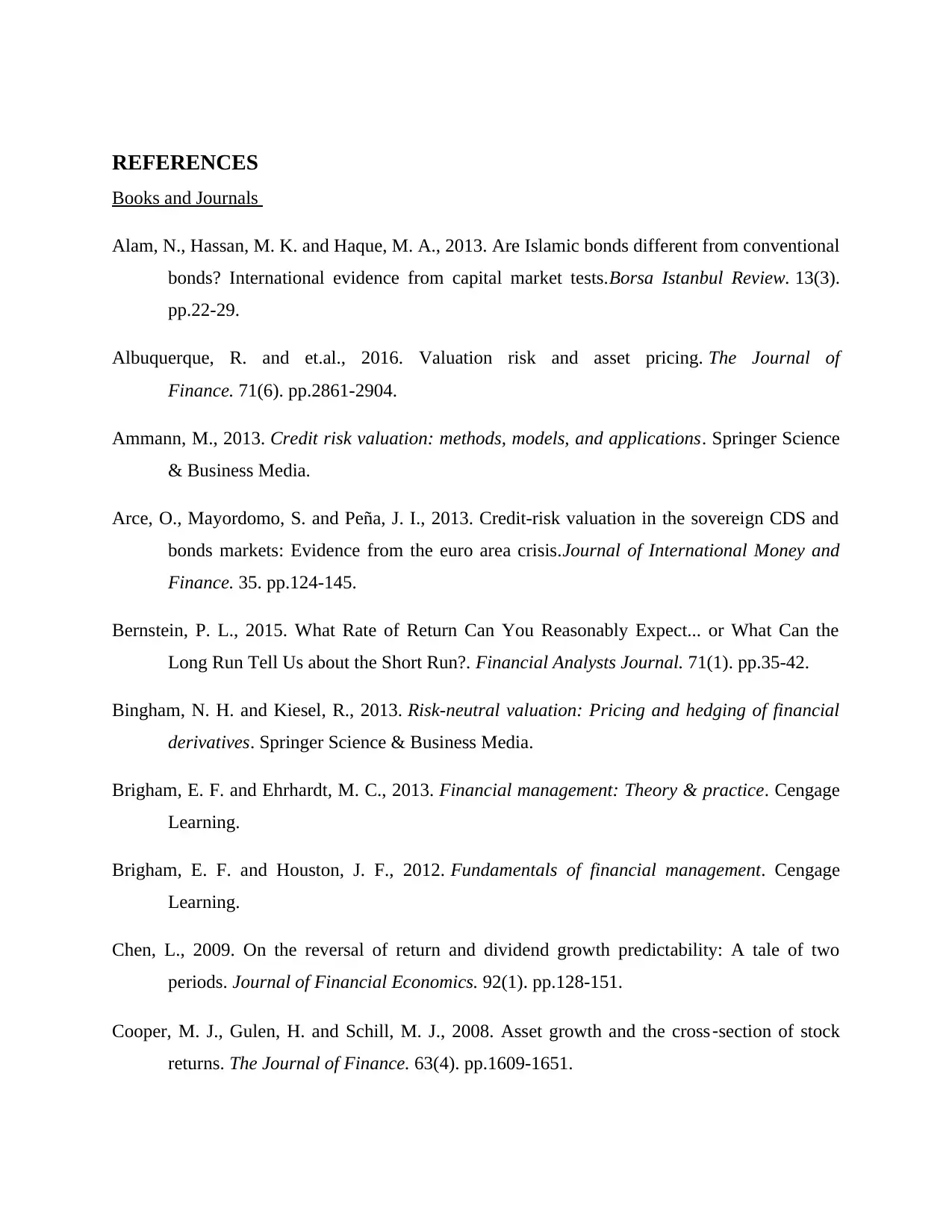
REFERENCES
Books and Journals
Alam, N., Hassan, M. K. and Haque, M. A., 2013. Are Islamic bonds different from conventional
bonds? International evidence from capital market tests.Borsa Istanbul Review. 13(3).
pp.22-29.
Albuquerque, R. and et.al., 2016. Valuation risk and asset pricing. The Journal of
Finance. 71(6). pp.2861-2904.
Ammann, M., 2013. Credit risk valuation: methods, models, and applications. Springer Science
& Business Media.
Arce, O., Mayordomo, S. and Peña, J. I., 2013. Credit-risk valuation in the sovereign CDS and
bonds markets: Evidence from the euro area crisis.Journal of International Money and
Finance. 35. pp.124-145.
Bernstein, P. L., 2015. What Rate of Return Can You Reasonably Expect... or What Can the
Long Run Tell Us about the Short Run?. Financial Analysts Journal. 71(1). pp.35-42.
Bingham, N. H. and Kiesel, R., 2013. Risk-neutral valuation: Pricing and hedging of financial
derivatives. Springer Science & Business Media.
Brigham, E. F. and Ehrhardt, M. C., 2013. Financial management: Theory & practice. Cengage
Learning.
Brigham, E. F. and Houston, J. F., 2012. Fundamentals of financial management. Cengage
Learning.
Chen, L., 2009. On the reversal of return and dividend growth predictability: A tale of two
periods. Journal of Financial Economics. 92(1). pp.128-151.
Cooper, M. J., Gulen, H. and Schill, M. J., 2008. Asset growth and the cross ‐section of stock
returns. The Journal of Finance. 63(4). pp.1609-1651.
Books and Journals
Alam, N., Hassan, M. K. and Haque, M. A., 2013. Are Islamic bonds different from conventional
bonds? International evidence from capital market tests.Borsa Istanbul Review. 13(3).
pp.22-29.
Albuquerque, R. and et.al., 2016. Valuation risk and asset pricing. The Journal of
Finance. 71(6). pp.2861-2904.
Ammann, M., 2013. Credit risk valuation: methods, models, and applications. Springer Science
& Business Media.
Arce, O., Mayordomo, S. and Peña, J. I., 2013. Credit-risk valuation in the sovereign CDS and
bonds markets: Evidence from the euro area crisis.Journal of International Money and
Finance. 35. pp.124-145.
Bernstein, P. L., 2015. What Rate of Return Can You Reasonably Expect... or What Can the
Long Run Tell Us about the Short Run?. Financial Analysts Journal. 71(1). pp.35-42.
Bingham, N. H. and Kiesel, R., 2013. Risk-neutral valuation: Pricing and hedging of financial
derivatives. Springer Science & Business Media.
Brigham, E. F. and Ehrhardt, M. C., 2013. Financial management: Theory & practice. Cengage
Learning.
Brigham, E. F. and Houston, J. F., 2012. Fundamentals of financial management. Cengage
Learning.
Chen, L., 2009. On the reversal of return and dividend growth predictability: A tale of two
periods. Journal of Financial Economics. 92(1). pp.128-151.
Cooper, M. J., Gulen, H. and Schill, M. J., 2008. Asset growth and the cross ‐section of stock
returns. The Journal of Finance. 63(4). pp.1609-1651.
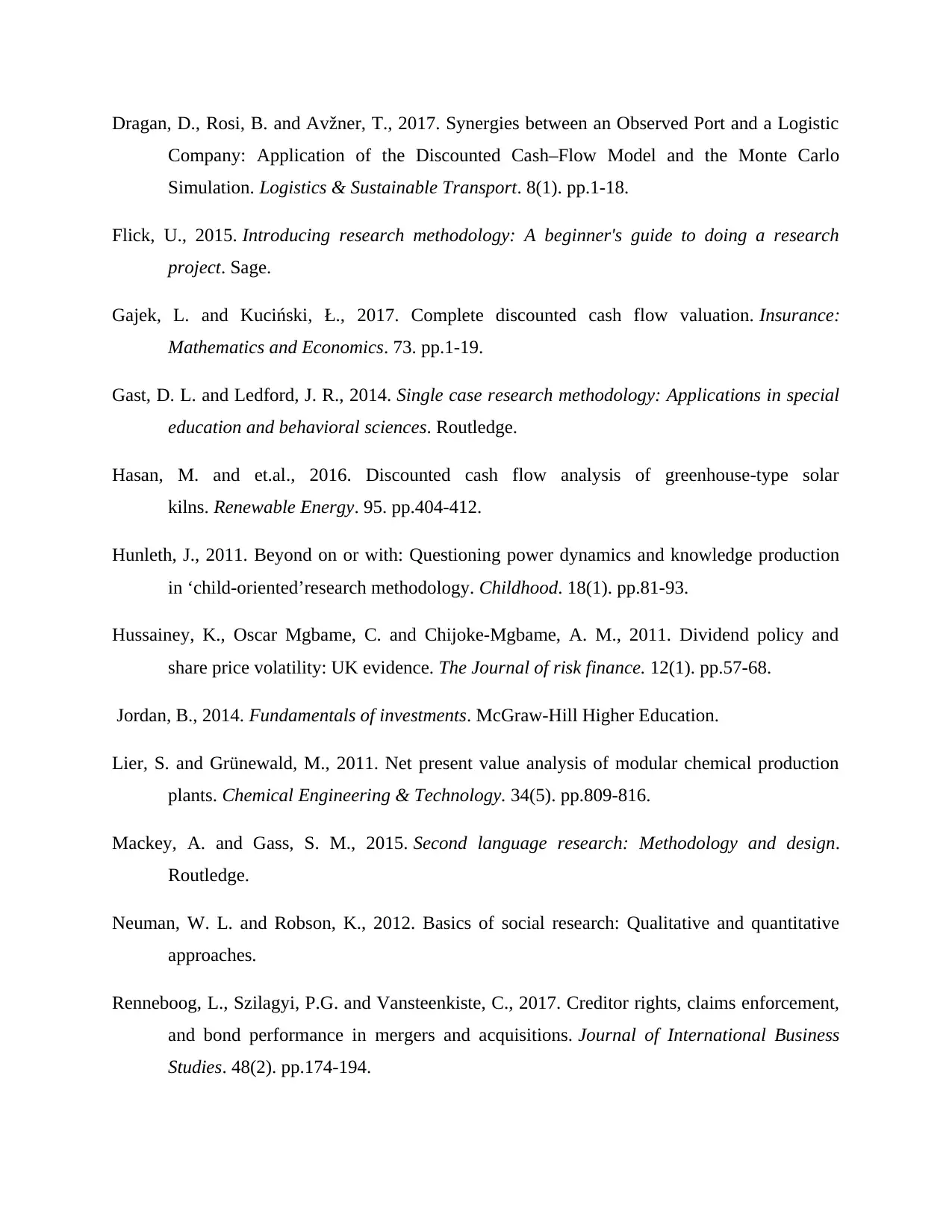
Dragan, D., Rosi, B. and Avžner, T., 2017. Synergies between an Observed Port and a Logistic
Company: Application of the Discounted Cash–Flow Model and the Monte Carlo
Simulation. Logistics & Sustainable Transport. 8(1). pp.1-18.
Flick, U., 2015. Introducing research methodology: A beginner's guide to doing a research
project. Sage.
Gajek, L. and Kuciński, Ł., 2017. Complete discounted cash flow valuation. Insurance:
Mathematics and Economics. 73. pp.1-19.
Gast, D. L. and Ledford, J. R., 2014. Single case research methodology: Applications in special
education and behavioral sciences. Routledge.
Hasan, M. and et.al., 2016. Discounted cash flow analysis of greenhouse-type solar
kilns. Renewable Energy. 95. pp.404-412.
Hunleth, J., 2011. Beyond on or with: Questioning power dynamics and knowledge production
in ‘child-oriented’research methodology. Childhood. 18(1). pp.81-93.
Hussainey, K., Oscar Mgbame, C. and Chijoke-Mgbame, A. M., 2011. Dividend policy and
share price volatility: UK evidence. The Journal of risk finance. 12(1). pp.57-68.
Jordan, B., 2014. Fundamentals of investments. McGraw-Hill Higher Education.
Lier, S. and Grünewald, M., 2011. Net present value analysis of modular chemical production
plants. Chemical Engineering & Technology. 34(5). pp.809-816.
Mackey, A. and Gass, S. M., 2015. Second language research: Methodology and design.
Routledge.
Neuman, W. L. and Robson, K., 2012. Basics of social research: Qualitative and quantitative
approaches.
Renneboog, L., Szilagyi, P.G. and Vansteenkiste, C., 2017. Creditor rights, claims enforcement,
and bond performance in mergers and acquisitions. Journal of International Business
Studies. 48(2). pp.174-194.
Company: Application of the Discounted Cash–Flow Model and the Monte Carlo
Simulation. Logistics & Sustainable Transport. 8(1). pp.1-18.
Flick, U., 2015. Introducing research methodology: A beginner's guide to doing a research
project. Sage.
Gajek, L. and Kuciński, Ł., 2017. Complete discounted cash flow valuation. Insurance:
Mathematics and Economics. 73. pp.1-19.
Gast, D. L. and Ledford, J. R., 2014. Single case research methodology: Applications in special
education and behavioral sciences. Routledge.
Hasan, M. and et.al., 2016. Discounted cash flow analysis of greenhouse-type solar
kilns. Renewable Energy. 95. pp.404-412.
Hunleth, J., 2011. Beyond on or with: Questioning power dynamics and knowledge production
in ‘child-oriented’research methodology. Childhood. 18(1). pp.81-93.
Hussainey, K., Oscar Mgbame, C. and Chijoke-Mgbame, A. M., 2011. Dividend policy and
share price volatility: UK evidence. The Journal of risk finance. 12(1). pp.57-68.
Jordan, B., 2014. Fundamentals of investments. McGraw-Hill Higher Education.
Lier, S. and Grünewald, M., 2011. Net present value analysis of modular chemical production
plants. Chemical Engineering & Technology. 34(5). pp.809-816.
Mackey, A. and Gass, S. M., 2015. Second language research: Methodology and design.
Routledge.
Neuman, W. L. and Robson, K., 2012. Basics of social research: Qualitative and quantitative
approaches.
Renneboog, L., Szilagyi, P.G. and Vansteenkiste, C., 2017. Creditor rights, claims enforcement,
and bond performance in mergers and acquisitions. Journal of International Business
Studies. 48(2). pp.174-194.
Secure Best Marks with AI Grader
Need help grading? Try our AI Grader for instant feedback on your assignments.

Wu, J. and et.al., 2016. Inventory models for deteriorating items with maximum lifetime under
downstream partial trade credits to credit-risk customers by discounted cash-flow
analysis. International Journal of Production Economics. 171. pp.105-115.
Zhang, Z., Liu, W. and Zhang, X., 2017. Valuation of convertible bond under uncertain mean-
reverting stock model. Journal of Ambient Intelligence and Humanized Computing. pp.1-
10.
downstream partial trade credits to credit-risk customers by discounted cash-flow
analysis. International Journal of Production Economics. 171. pp.105-115.
Zhang, Z., Liu, W. and Zhang, X., 2017. Valuation of convertible bond under uncertain mean-
reverting stock model. Journal of Ambient Intelligence and Humanized Computing. pp.1-
10.
1 out of 35
Your All-in-One AI-Powered Toolkit for Academic Success.
+13062052269
info@desklib.com
Available 24*7 on WhatsApp / Email
![[object Object]](/_next/static/media/star-bottom.7253800d.svg)
Unlock your academic potential
© 2024 | Zucol Services PVT LTD | All rights reserved.


